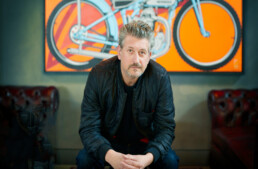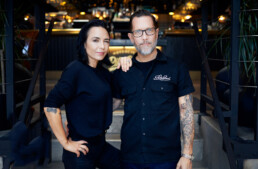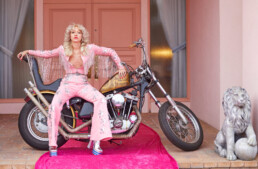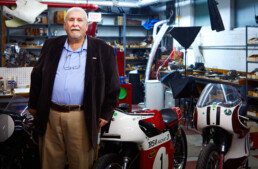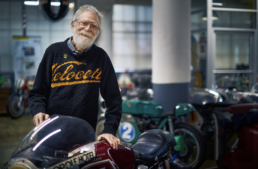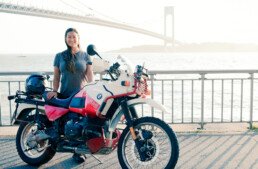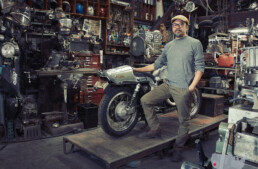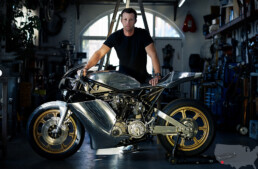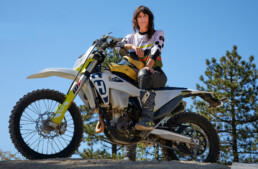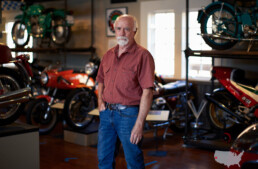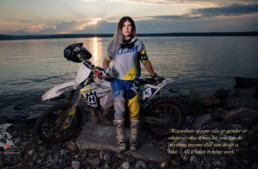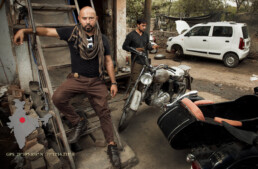The Motorcycle Portraits: Conrad Leach
The Motorcycle Portraits is a project by photographer/filmmaker David Goldman, who travels the world making documentaries, and takes time out to interview interesting people in the motorcycle scene, wherever he might be. The result is a single exemplary photo, a geolocation of his subject, and a transcribed interview. The audio of his interviews can be found on The Motorcycle Portraits website.
The following is a portrait session with Conrad Leach, an artist, former fashion designer, and early member of the Mean Fuckers MC in London. We've featured Conrad in The Vintagent many times since 2006(!), he's a kindred spirit and a great friend. David Goldman caught up with Conrad in Los Angeles on February 15 2023, and asked him a few questions about motorcycling: the following are his responses:

Please introduce yourself.
My name is Conrad Leach, and I'm a painter. I’m was originally from London and I moved to Los Angeles 10 years ago, and now I’ve made LA my home.
What was your introduction to bikes?
My first introduction to motorcycling or motorcycle culture, really, I was in West London and I bumped into a bunch of guys who were all riding vintage bikes. And they were all really cool individuals and people that I wanted to hang out with and be my friends. And they wanted me to be their friend to, and all of a sudden a bike was available.

I bought it off a friend of mine, and fell instantly in with a bunch of guys who were all young and rolling around way too fast, central London on vintage motorcycles. And that's really what lit the fire for me. I always wanted, I think to be involved. I was always really attracted to the aesthetic and the attitude and what have you. But yeah, my story is not really growing up. I mean, I had bikes when I was a kid, but it was not really from there that made me sort of want to get really seriously involved. It was really the sort of social aspect of it in London at the time that I was there.

How did you come to paint bikes?
Basically, I was a painter that got quite lucky. At the beginning of my career, I had a big show in London, and became the artist in residence for Louis Vuitton in Tokyo. And I was very well known for my portraits. But in my private life, I was very, very deeply involved in vintage motorcycle culture, so I decided to make a few paintings based on motorcycle culture. they looked at the four most important aspects of motorcycle culture as I saw it, and a friend of mine showed them to Jared Zaugg who was just starting to put together the Legend of the Motorcycle event at Half Moon Bay in California in 2006. And he asked me if I would show these paintings at his event. At first, I was a little bit peeved that my friend had told people that I was making motorcycle paintings because I felt it was too obvious that I was making motorcycle paintings, because I was so involved in vintage motorcycle culture. But I did agree and I liked Jared and I thought that his event was going to be amazing, which it was. And it was a real linchpin moment. I've met many, many people throughout the world who are still my friends today, as a result of Jared allowing me to attend the event, you know, with my paintings. I mean, all the paintings sold, and I met the most amazing people as a result.

And it was sort of like the beginning of the roller coaster into motorcycle art. But it was never something that I set out to do. It was just merely a subject, like I just painted a load of buildings in LA recently. As I said, I was more well known as a portrait painter, particularly in Japan. I was painting well-known celebrities and developing a thing called Pop Ukiyo-E, which was harking back to the early days of wood cutting in Japan and applying it to modern culture, and also trying to blend the influence of Japanese culture, American culture and British culture. That was the original concept. And then I applied that concept to how to produce images of motorcycle culture. And the results were were pretty successful, or I thought they were pretty successful. And other people thought they were pretty successful. As a result, I am often now asked to make motorcycle-related paintings. And obviously, people see that logical link, between me and motorcycling and art, and blending the whole thing together with a particular aesthetic and a particular angle.

What is a great experience or story attributed to motorcycles?
Great experience as a result of motorcycles? I mean, I've had loads, the one that is very significant is obviously meeting my wife at the Motorcycle Film Festival, the very first Motorcycle Film Festival in LA. I was just here doing some charity riding for AMFAR and Kiehl's. And the night before that event kicked off, a friend of mine took me to this film festival, the first motorcycle Film Festival of its sort in LA. And I bumped into my wife and that was the first time we met. And then subsequently, I came back to LA and had a painting show and got to know her a little bit better. And we decided to get serious. So you know, motorcycling completely changed my life.

Before that, I was rolling around London with a gang of guys, you know, doing my thing. And then all of a sudden, I'm getting very serious about a girl in LA, which was not something that I had planned, but I'm so glad I did, because she's like a fantastic, fantastic wife and a fantastic motorcycle rider. In fact, I've ridden through the desert a couple of times with her: LA-Barstow-Vegas. And we took our bikes to Saitama in Japan, where she won the women's section of the motocross racing, and another time she rode 60 miles through the desert with a broken foot. So, you know, I mean, that's not the reason I'm attracted to her, but she's got that motorcycle edge that I can relate to.

What do motorcycles mean to you?
Well, it's really hard to have a specific answer, because I think the umbrella aspect of motorcycles is something that really needs to be considered. You know, one minute it can be about long-distance road riding, the next minute it can be all about desert riding, the next minute it can be about how it makes you feel as a result of riding, how it gets you inspired, aesthetically, then by the way people perform either on a bike or the way that they carry themselves with their clothing or their attitude or what have you. I think that broad church of motorcycling is what the appeal is, for me. It's not a particular thing, it's the fact that it is truly for everybody.

It's very zeitgeist in a way; everybody is constantly trying to capture this lightning in a bottle around motorcycling. And it's just constantly moving, is how I see it. I mean, I remember my experiences of motorcycling and what it did for me. And I know that someone a couple of years later had a completely different experience. You know, I think that's the best way for me to answer the question - without really answering - because I think it's that lightning in the bottle aspect of motorcycling. That is the appeal.
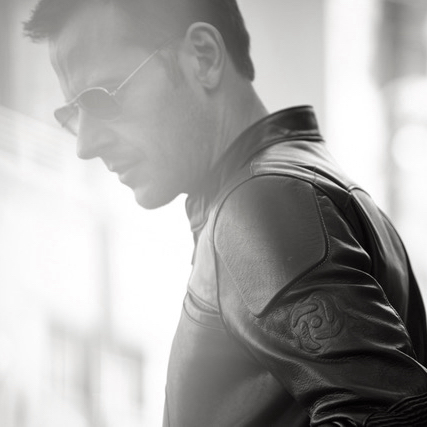
The Motorcycle Portraits: Dutch and Vikki
The Motorcycle Portraits is a project by photographer/filmmaker David Goldman, who travels the world making documentaries, and takes time out to interview interesting people in the motorcycle scene, wherever he might be. The result is a single exemplary photo, a geolocation of his subject, and a transcribed interview. The audio of his interviews can be found on The Motorcycle Portraits website.
The following is a double-portrait session, with Vikki and Dutch Van Someren, the co-founders of the Bike Sheds in London and Los Angeles, which have become important 'neutral ground' for motorcyclists of all types and inclinations. The Bike Sheds feature a great restaurant and bar, barber and tattoo shops, a motorcycle and gear emporium, plus even spaces, all of which is surrounded by very cool custom and vintage motorcycles on display and/or for sale. David Goldman caught up with Dutch and Vikki at the Bike Shed in Los Angeles on February 15 2023, and asked them a few questions about motorcycling: the following are their responses, wtih Vikki taking the lead.
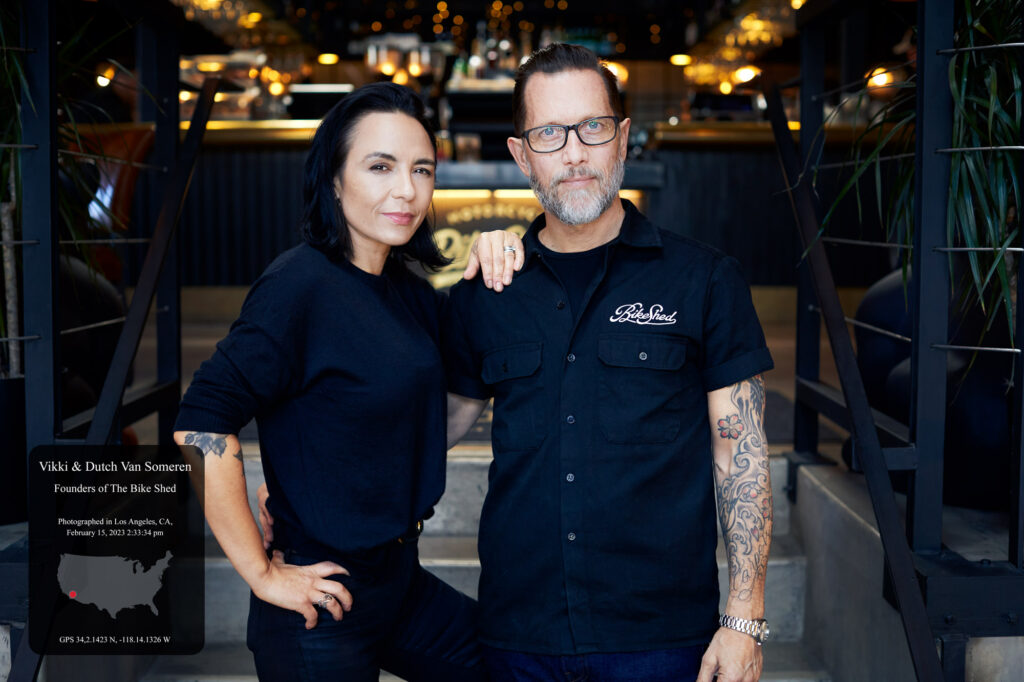
Please introduce yourself:
My name is Vicky Van Someren and I'm the co-founder of Bike Shed and we are currently sat in LA enjoying the sunshine.
How did you first get into motorcycles?
How I got into biking was when I was a kid. I was bought a little 50cc Honda because my stepdad used to ride and build bikes. He had an old Matchless and we used to watch him riding in the woods and crashing it all the time. So yeah, that was how I got into it.
What is a great experience or memory that you have that is directly related to motorcycles?
So a great experience I've had that directly aligns with motorcycling was really about the BikeShed community response. A friend contacted me, I hadn't spoken to her for a few years and she was like, you know lots of people, my mum and dad are recovering from cancer, they live in the middle of nowhere, we can't travel because there was a travel ban and they need food and they can't go out. So I reached out to some of our members and I was thinking there must be loads of people out there that need help but can't get any. I reached out to a few members and between us all we created the BikeShed Community Response and we delivered food for over 22 months, over 30,000 deliveries.
But the thing that really got me was not only we were helping save other people's lives, the riders were saying that we helped them save their lives and finally they had some purpose during COVID. But also we got contacted by a lady and sadly her partner died riding his bike and she thanked us for giving him the last month of his life a great purpose and he was the happiest he'd been for a long time.
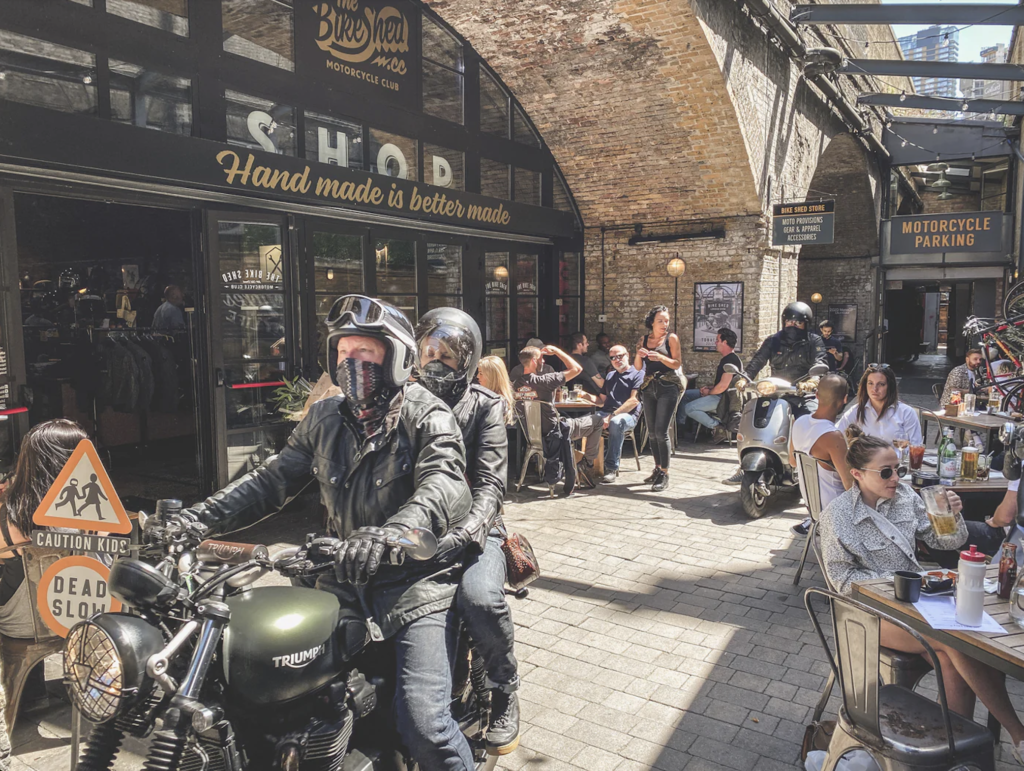
What does motorcycling mean to you?
Really for me it's about the common ground, it's about the fact that it's the thing that brings people together instead of - in this crazy world - that pushes people apart. It's about the freedom you feel, it doesn't matter what sex you are, who you are, when you're on your bike, and with the road, you are one.
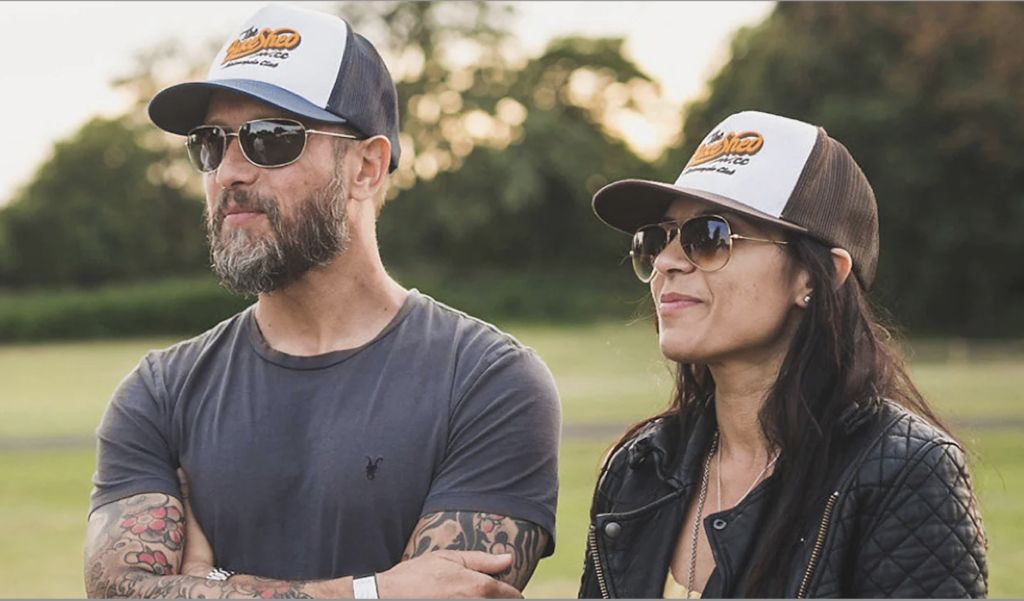
Please introduce yourself:
Hi, my name is Anthony 'Dutch' van Someren. I'm here in LA at the LA bike Shed moto destination. I've been riding motorcycles since I was 17 years old. Soon as I was allowed to, as soon as that was a thing that I was old enough to do. I'm the co- founder and co-owner of Bike Shed Motorcycle Club in London and in Los Angeles. We've been open here in LA now since April last year. So it's been a minute really enjoying the warm welcome and the warm sunshine.
How did you get started:
So when I was 16 or 17, if you wanted to go anywhere, you bought a motorcycle. Back in the 70s you didn't just buy a car. I grew up in Sussex, outside London. And and you know, it was kind of fairly populated, but it's the countryside, the countryside with big towns. And if you wanted to go to the pub or see your girlfriend or see your friends, if you didn't want to walk or cycle or take the bus, you bought a motorcycle. And it was the era of the trail bikes that looked like motocross bikes. So my first motorcycle was a Suzuki TS125X look just like an RM250. I thought that was awesome. And I had a whole bunch of friends who are a little older than me because I was in a punk rock band. They were the grown up older punks, I was the young new punk, they all rode dirt bikes. And they dragged me from destination to destination from pub to club, we'd ride to Brighton, we'd ride to London, we would take our bikes on military testing grounds for testing tanks, and get chased by the military police. But yeah, what really got me into it was that freedom, that ability to travel and get around. But obviously the motorcycle was also an accessory. It's part of who you are. It defines how you're dressed that day, and what you can take with you. And so it turned very quickly from being transport into culture and into lifestyle, and into a big piece of who I am.

What is a great story or experience that you can attribute to Motorcycles?
What I really love about motorcycles is the stories and the adventures they create, but also the way they bring people together and the kind of humanity you see amongst riders, because for me, motorcycle riders, they're a little bit different from everybody else. And we talk about common ground, and we talk about leaving your differences at the door. But often you see even deeper than that; you see into humans and human nature. We have a club, but you don't have to join, we always say we're kind of 'exclusively non-exclusive.' But one of the things that I really think about this culture, and what we're trying to continue to create and encourage. Our membership had a big ride out to Wales, out in the country on adventure bikes, you know, riding through trails and green-laning. You know - soft off-road road riding. And there was about a dozen guys led by Dan, who runs our memberships. And one of the guys had been really unwell for a long time, he was recovering getting back to health. And he was like, 'Look, I'm, I'm kind of pretty weak, and I get tired quite easily.' And the whole of the group were like, 'don't worry about it, you know, if you're tired, if you're struggling, you know, we'll take care of you.' But he was doing pretty well. And they were riding through Wales, and it was foggy, and kind of that misty kind of rain. And he was lagging further and further behind. And Dan was at the back looking after him. And after a while, he just pulled the bike over and stopped. And he said, 'Look, I'm so tired. I can't go on.' And they had a destination to get to everybody was waiting to get back to this kind of little bed and breakfast that they were all staying at and looking forward to drinking beers and telling stories about the day. Dan answered, 'Look, don't worry, just sit by the road. Let's just get your energy back.' So they sat by the road for like an hour, maybe a couple of hours while he got his energy back. And Dan was saying, 'Look, if you want, I'll take you on the back of my bike, and we'll pick your bike up later. Don't worry about it. We'll just get you to the bed and breakfast.' And he was like, 'no, no, I think I can get on the bike.' So they started to continue down the road. And then they got to the first junction. And there's one of the members waiting right there on the corner. The backmarker. And they were like, 'Dude, you're still here.' And he goes, 'Yeah, well, I'm not going to leave anyone behind.' So he was waiting, and they picked him up, and they got to the next junction. There's another guy there waiting. Then they get to the next junction. There's another guy with they're waiting, every single member stopped and waited. And I guess everybody knows the rules. That's what you're supposed to do. But Dan kind of assumed, because everybody's got each other on the GPS, and everyone was just going back to the hotel. No one wanted to leave. And the guy was transformed from that experience. And he said, 'Now I really understand what this club is all about. Now I understand what bike riders are all about.' And you know that the club isn't some brotherhood, we're a bunch of people that like motorcycles, but it really showed me the caliber of human and how far they go when it comes to looking after their fellow riders.
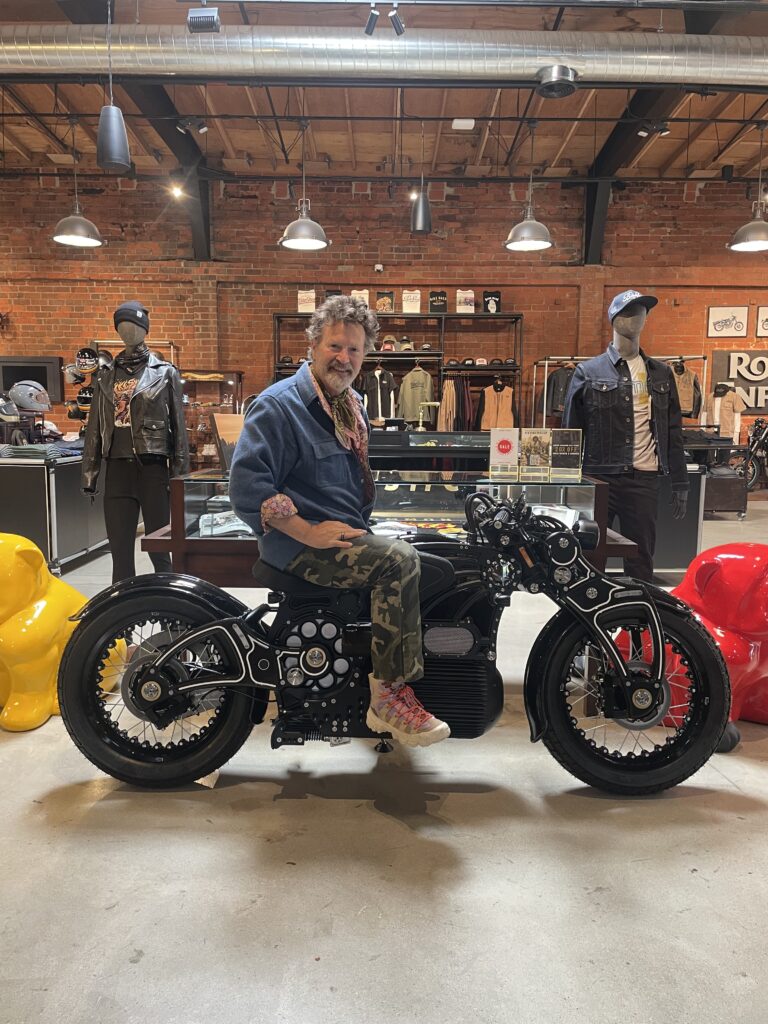
What do motorcycles mean to you?
Motorcycles mean a lot of things to me. And that's changed through time: when I was a teenager, it was freedom. Freedom to go where I wanted on my own agenda and my own timescale, and I've always carried that through with me. That's a common thread; having the idea that you can always get on your motorcycle and go somewhere. I mean, even a few years ago, when they had the terrorist attacks in London, and public transport came to a close, I knew I could get anywhere on a motorcycle. You know if my wife needed me I could get to wherever she was. If my kids needed me, I could get on a bike and I could get there. And it didn't really matter what else was going on. It's kind of the ultimate utilitarian get-there vehicle. And we had that as well in the Bike Shed Community Response during COVID. We used our members and our customers as a network of couriers, and we were delivering PPE and food and equipment. We were the first people to deliver COVID tests on behalf of the National Health Service in the UK. And they trialed it with us. And we deliver tests to surgeons to see that they didn't have COVID. So they could go to work that day and do their surgeries. For me, there's always been that element of this kind of freedom. I've got this bike, as long as it's fueled up, and I've got the keys and the batteries charge, no one's going to stop me going anywhere.
The second thing that has really come to me over time is escape. Because in a world that's really interruptive, and digital, and your phone's always beeping and going off and people expect to have access to you all the time. When you put that helmet on, and you start your bike up and you get on the road, no one can get to you. And I love the feeling of hearing my mobile phone vibrating in my pocket and going no, no, I'm on a motorcycle. I'm not going to get that. I'm going to leave that and you really do leave all your troubles behind. And it really is this mindful in-the-moment experience where no one can get to you.
And in the last 10 years, it's also been my business, my life, my passion. You know, opening Bike Shed was all around motorcycles and motorcycle culture. And I also love them as art objects and as engineering and as design. You know, I'm an aesthetic person, and I love toys. And for me, motorcycles are still the ultimate mix of design and mechanics and experience. So there are a whole bunch of things: a metaphor for freedom, and a metaphor for analog in a digital world, and real experiences in a virtual world, where most things are fake. Motorcycles and motorcycle people are not fake.

The Motorcycle Portraits: Jamie Nelson
The Motorcycle Portraits is a project by photographer/filmmaker David Goldman, who travels the world making documentaries, and takes time out to interview interesting people in the motorcycle scene, wherever he might be. The result is a single exemplary photo, a geolocation of his subject, and a transcribed interview. The audio of his interviews can be found on The Motorcycle Portraits website.
The following portrait session is with Jamie Nelson, a professional fashion photographer, whose legendary pink house with its extraordinary interiors is often a character in her photo shoots. If you mash up Marylin Minter's glitter portraits with '70s era Oui and any era Easyriders magazine with some Barbie set design, you have glimpsed the soul of Jamie Nelson's art. David Goldman caught up with Jamie at her home in Los Angeles on February 16 2023, and asked her a few questions about motorcycling: the following are her responses.
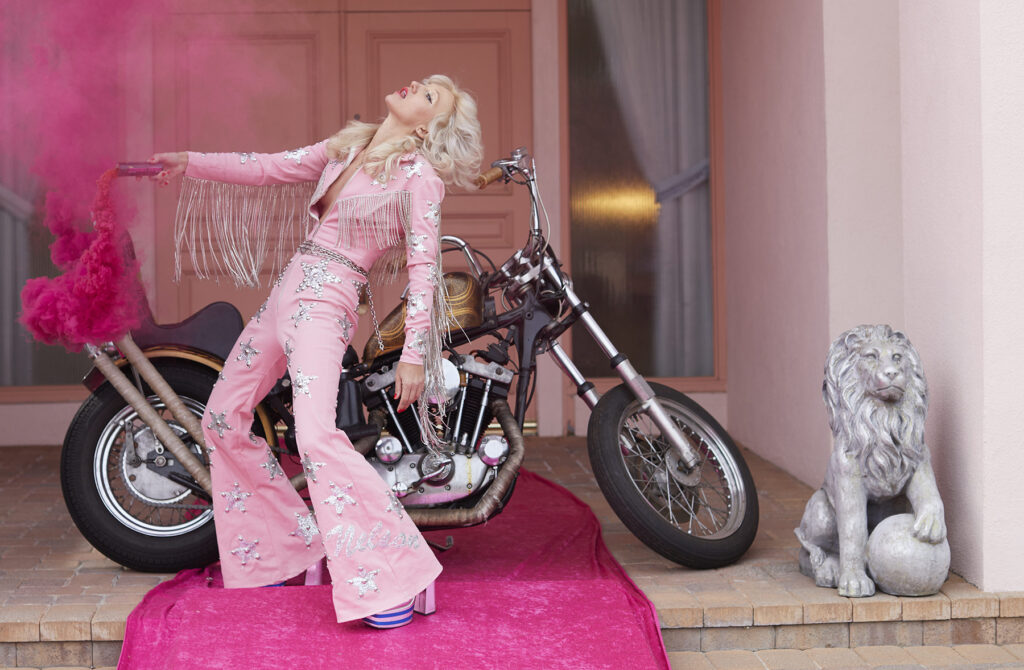
My name is Jamie Nelson. I'm a fashion and beauty photographer. We're here in Los Angeles at my pink house. And I've been riding motorcycles for about 10 years,
How did you get started with motorcycles?
I was living in New York City doing the whole fashion photography thing. It was interesting that everybody was wearing these leather jackets, and motorcycle fashion was on trend at the time. And I was kind of sick of seeing all these girls wearing motorcycle jackets and not riding and I was like, I want to wear that and actually ride. Some of my girlfriends expressed interest in going to a class with me, and it just didn't pan out. And they kept delaying and delaying. So I just went by myself.
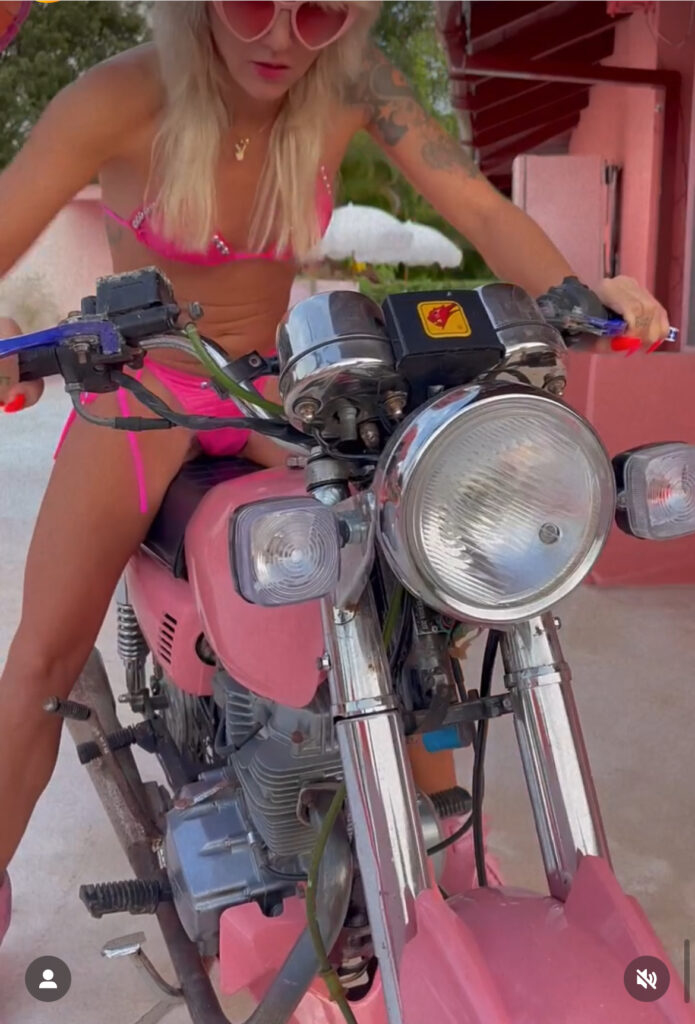
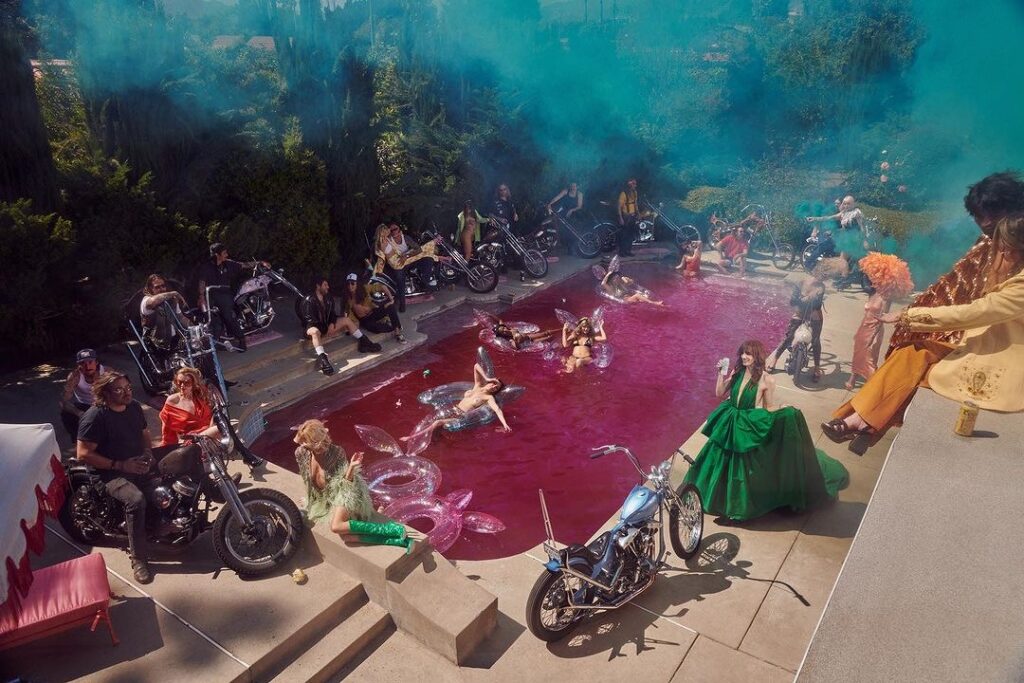
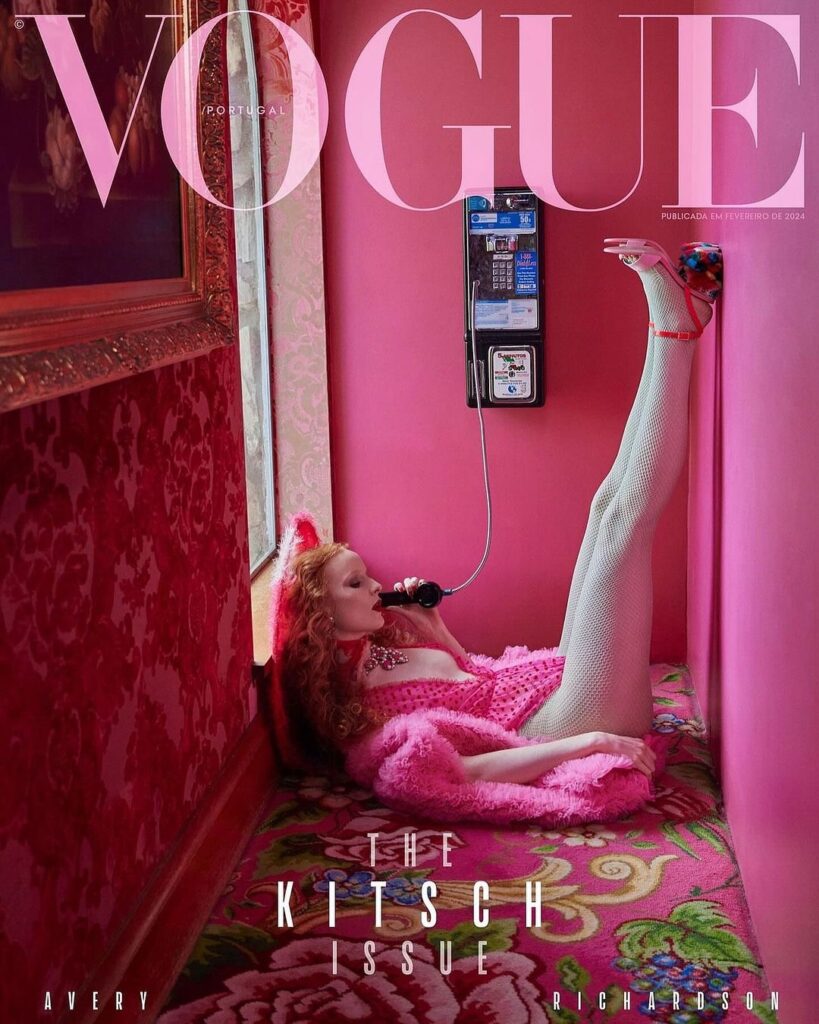
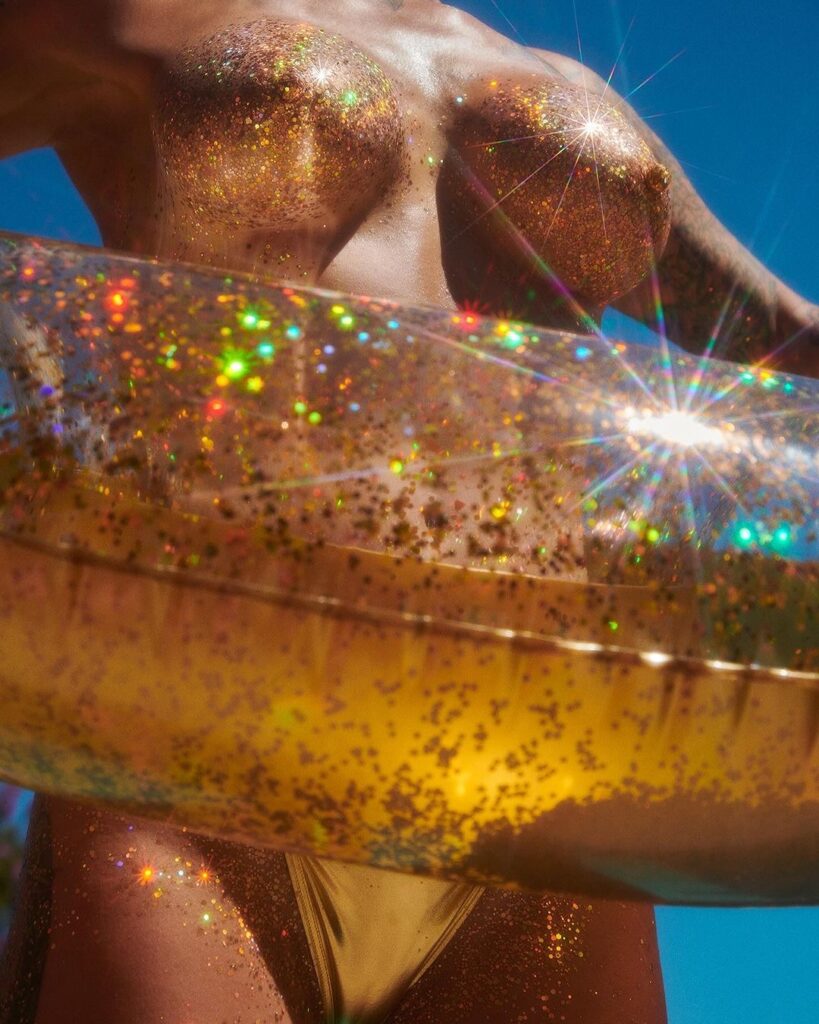
Its’ interesting because like it first I mean, everything takes practice, including getting naked. At first you're shaking - I dropped my bike in front of everybody - but the amount of support I got from other women...coming up to me saying, 'You've inspired me, you're so brave, I wish I could do that.' And it just became a thing that I did over and over. I'd meet people they'd say Naked Girl. And they remember me from all these different states, all these different events I go to, I found that so interesting. But that's something about just being brave. And being yourself; that takes practice too. And you can connect with people on that level, even if it's just getting naked. It sounds kind of superficial.
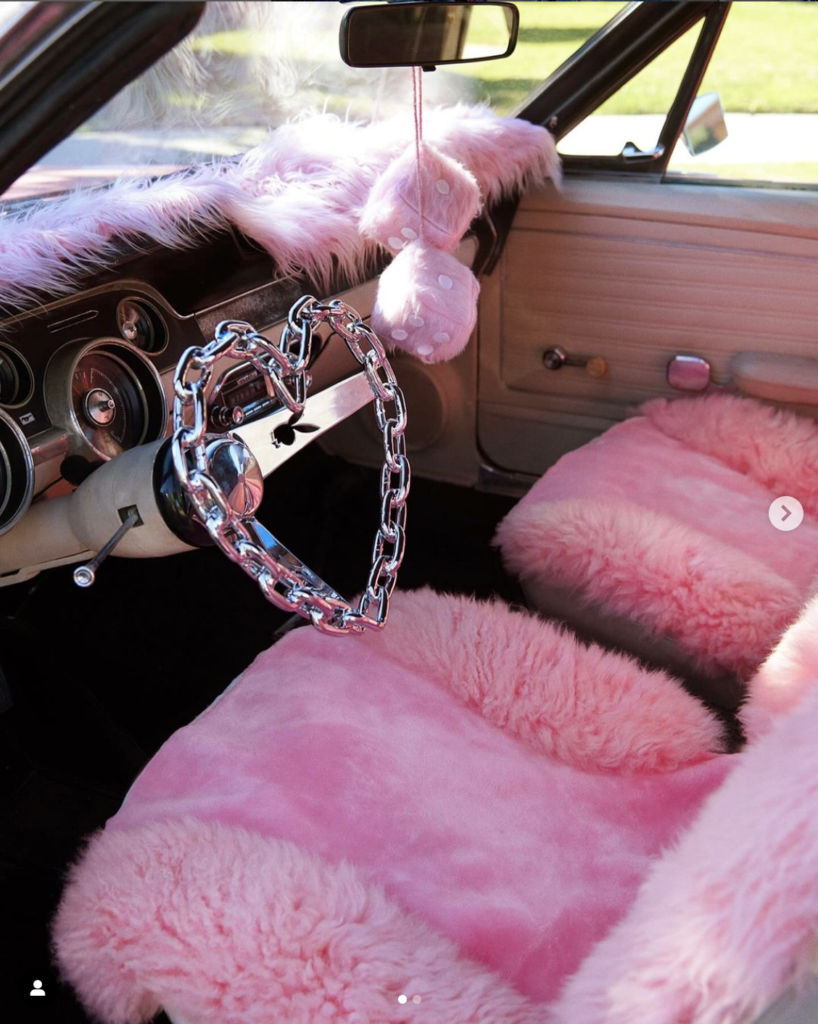
I have a lot of good memories with a particular girlfriend of mine, Adrienne, and we would go to all these different events together. She actually passed recently, from a lot of different health issues she had. And it was amazing seeing the community, with the Miss-Fires and everybody, sharing all the memories we had and seeing videos of all of us having such a good time. And those were the best moments for her, being on her bike.
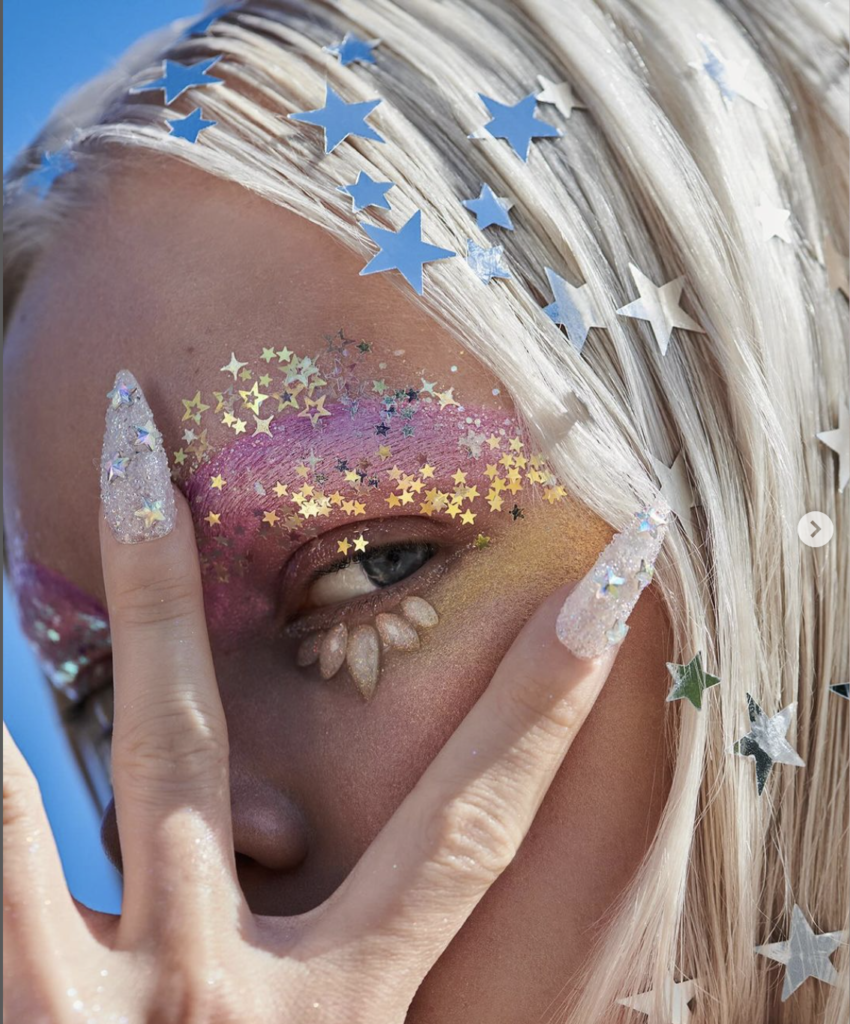
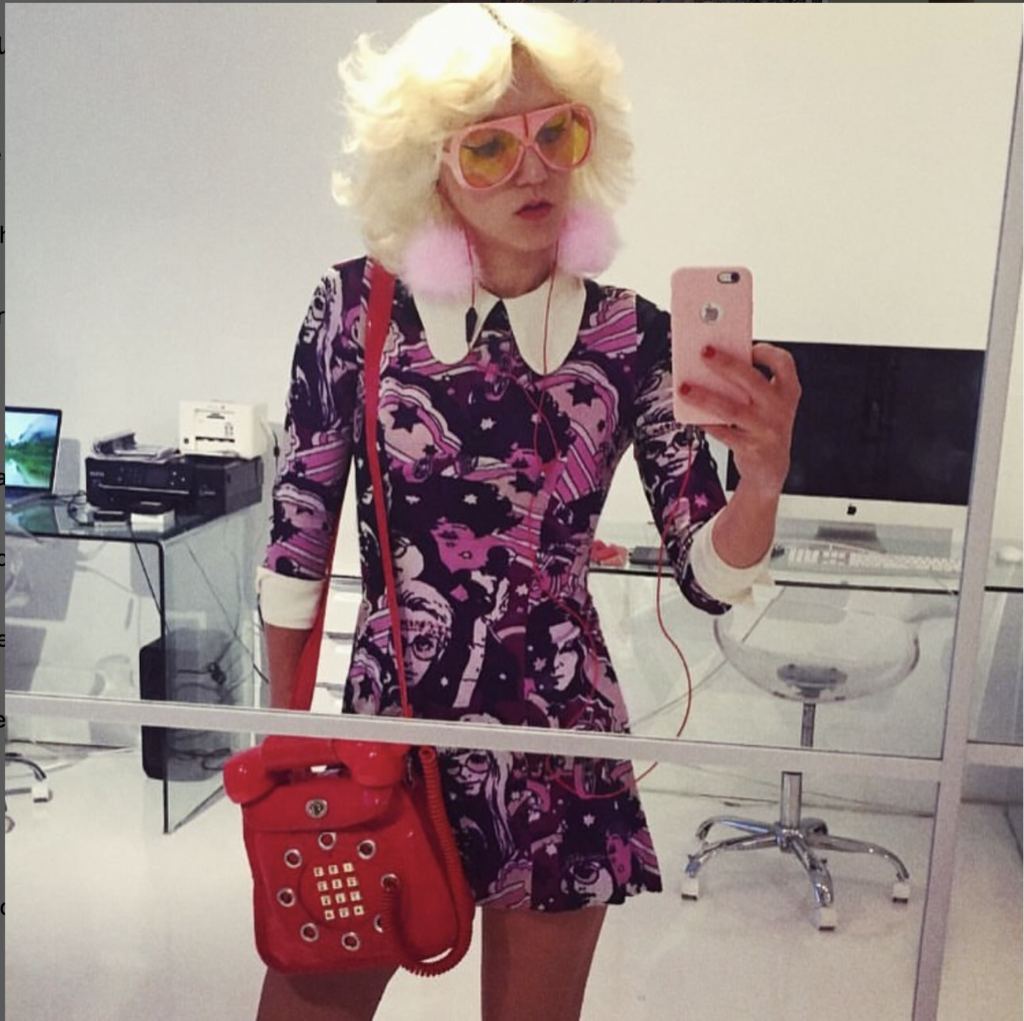
Motorcycles, for me mean strength, ultimate femininity, freedom, and really just a break from what I'm doing on a daily basis, to being my true self, and conquering things that I'm scared of. There are so many different types of riders, and I'm able to connect me with people that maybe I wouldn't have connected with in any other way. It's also just, you know, an escape from a certain industry. I think it allows everyone to be a little trashy and fearless and reckless. And I think we all need that in life, right? This is a break from the day to day grind.

The Motorcycle Portraits: Rob Iannucci
The Motorcycle Portraits is a project by photographer/filmmaker David Goldman, who travels the world making documentaries, and takes time out to interview interesting people in the motorcycle scene, wherever he might be. The result is a single exemplary photo, a geolocation of his subject, and a transcribed interview. The audio of his interviews can be found on The Motorcycle Portraits website.
The following Motorcycle Portraits session is with Rob Iannucci, owner of Team Obsolete, the legendary vintage racing juggernaut that has been the lifeblood of authentic historic motorcycle racing for over 40 years. Rob has his headquarters in Brooklyn NY, where he keeps a museum-worthy collection of important racing motorcycles from the USA, Italy, the UK, and Japan. All his machines are extremely rare and coveted, with rich histories and contemporary stories, too. David Goldman attended the annual Team Obsolete holiday party in Brooklyn, and took the opportunity to photograph and interview Rob.
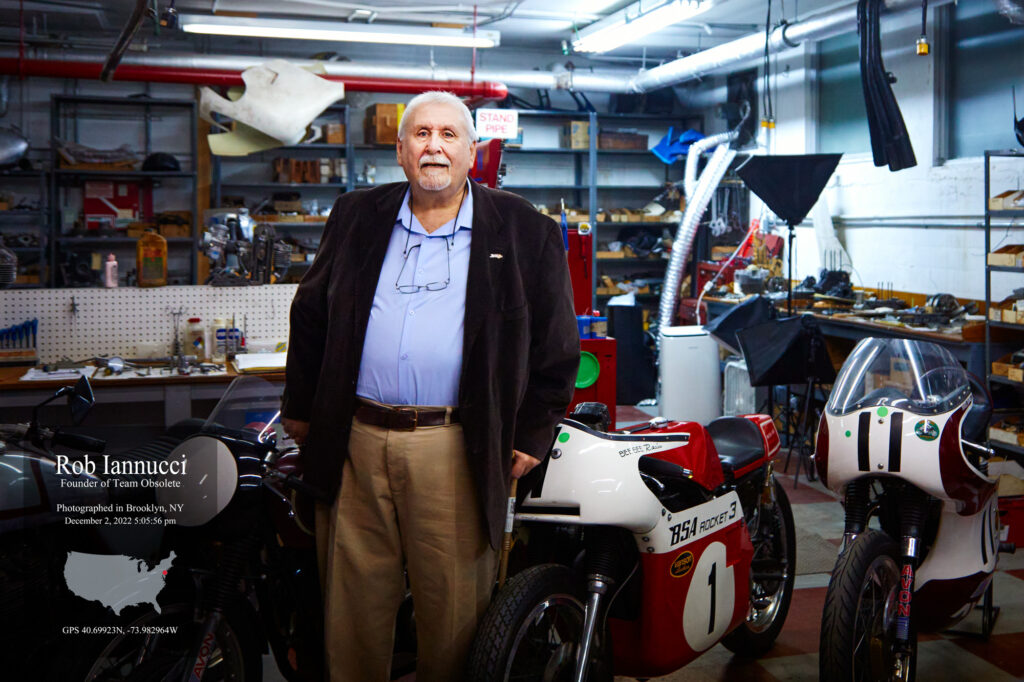
Who are you?
Hello, my name is Rob Iannucci. And we're here at the Team Obsolete headquarters in downtown Brooklyn in the historic Clock Tower building. We're here among our collection of historic racing motorcycles; these bikes have been a major passion of my life, and it doesn't take much in stimulation to get me to talk about them.
How did you get started with motorcycles?
Well, the way I got involved with motorcycles was I was in a Peace Corps in the Caribbean, and I needed a small motorbike to get around, and it grew. From there, I wound up ordering a Norton Commando from England, which was delivered directly to me in the Caribbean. And eventually, I was back in the United States, and hooked up with a bunch of British bike enthusiasts. And it all grew from there
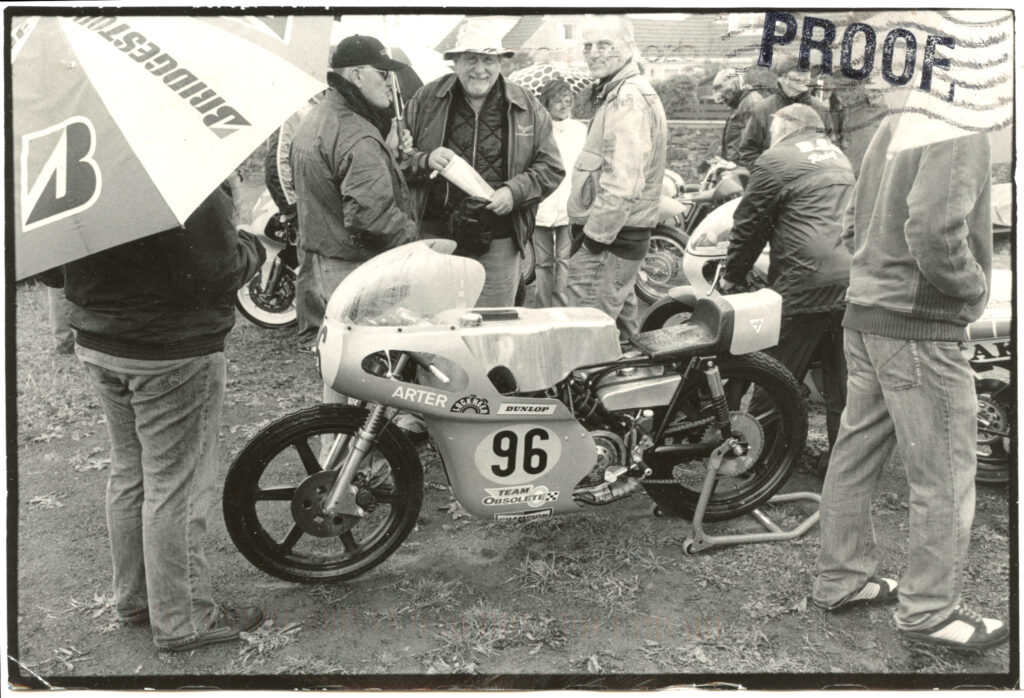
What's a great story that could only have happened with motorcycles?
The origin of Team Obsolete started after I came back to the United States, when my Peace Corps work was over, and I had myself a new Commando. I hooked up with some British bike enthusiasts, and we wound up going into some races. Also, I discovered the Matchless G50 engine in an old magazine article. And it was just a really, really brilliant piece of engineering, which had begun its development in the 1920s. And I just fell in love with it. So I had to have one...and then I had to have two...and then I had to have three, and then I had to have more. And they were scarce; they weren't raised much in this country, but it was just a beautiful piece of architecture. It was, you know, it was artful. It was brilliant. And it was built for a no-factory racing operation, so is simple to work on.
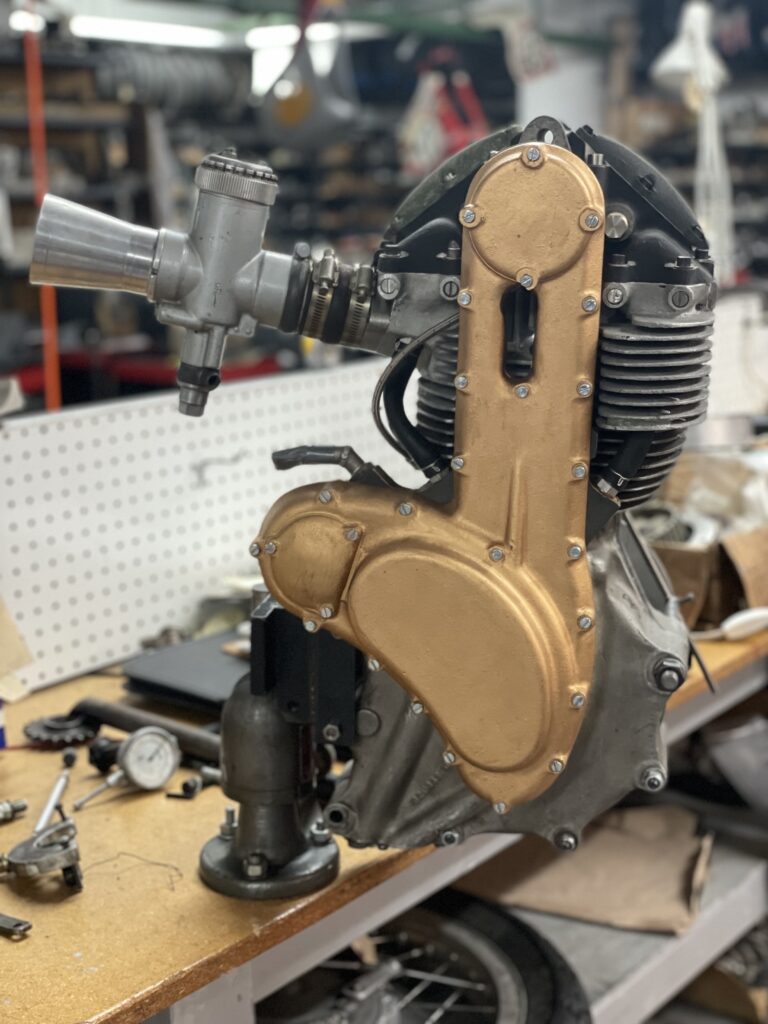
So I wound up with quite a few Matchless G50s. We raced them, and I interfaced with people who had raced them 20 years before, when they were current. And they were very happy to help me, in many different ways. And then I needed some riders because we wanted to go racing. I wanted to race a little bit myself, but I wasn't a talented rider. So I got some other riders, and eventually hooked up with David Roper, who's really kind of the King of Historic Racing Motorcycles as a rider. And we just went out and started racing bikes, and we had a great time.
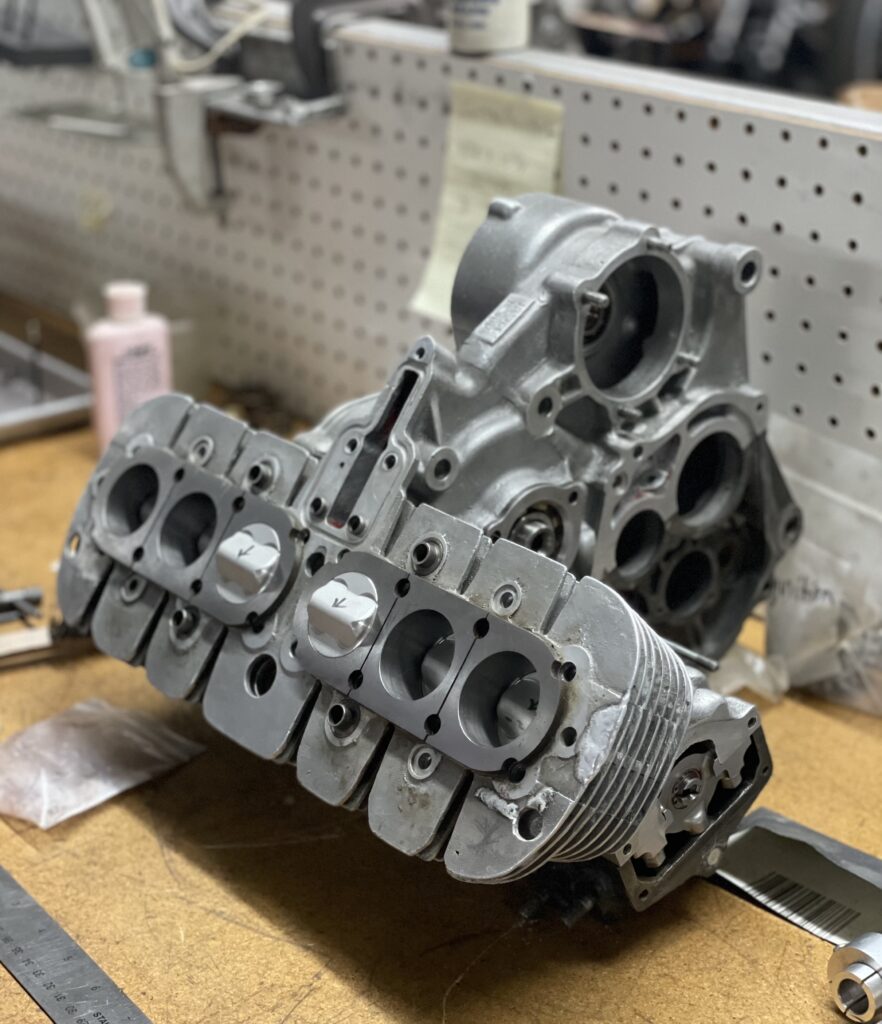
It was just the most fun thing I've ever done in my life. It was educational, there was camaraderie involved in it, it was, you know, just great way to spend your energy. I organized Team Obsolete in the late 70s. And it grew into something that was beyond my wildest dreams or intentions; we wound up entering about 1800 races worldwide over a period of 35 or 40 years. We've had 50 different riders, we've collected the finest historic racing motorcycles in the world. And we raced them! The whole idea was to put these bikes back on the track, to the extent that was possible to recycle the original riders and bring them back. And we've done quite a bit of that also. And it just grew, you know, there have been fabulous opportunities all over the world, we've raced all over the United States, in Asia, and Australia and New Zealand, all over Europe. And the whole idea was that the bikes needed to be raced and should be raced, rather than just paraded or, you know, be a museum piece. So there is a kind of big, historically educational aspect to it as well, because there are many people who weren't alive when these motorcycles were being raced originally. And now they have a chance to see them, you know, 30 or 40 or 50 or 60 years later.
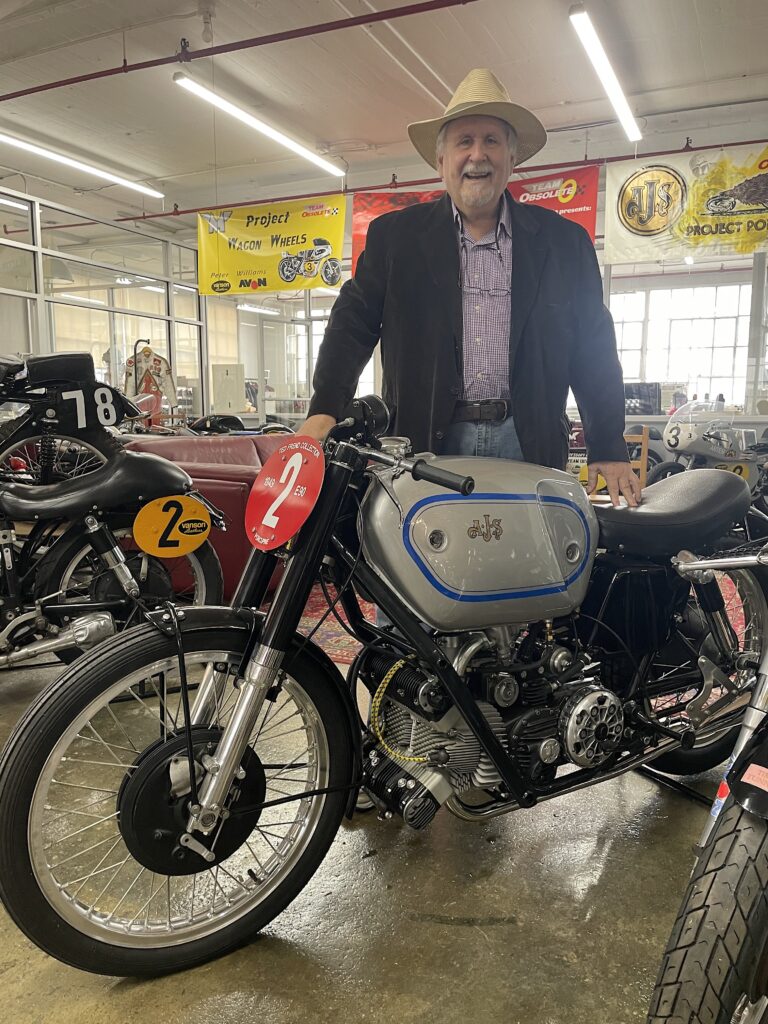
What do motorcycles mean to you:
The whole idea of the meaning of motorcycles... it means different things to different people. We are involved in a very esoteric end of the sport. There are vintage motorcycles, and they were built for purpose of racing, they're racing motorcycle, so they're not designed to be used on the street. They're not designed for the average person to own them, or to operate them. They're very, very single, narrow purpose, designed just to go out and win a race. And hopefully they're still running at the end of the race. And then they require a great deal of maintenance and attention and so forth before the next race. But the engineering involved in these bikes is very, very special. And that's what I find that very attractive, because they were built with passion by the factories, to publicize their activities to the general public.

The Motorcycle Portraits: Dave Roper
The Motorcycle Portraits is a project by photographer/filmmaker David Goldman, who travels the world making documentaries, and takes time out to interview interesting people in the motorcycle scene, wherever he might be. The result is a single exemplary photo, a geolocation of his subject, and a transcribed interview. The audio of his interviews can be found on The Motorcycle Portraits website.
The following Motorcycle Portraits session is with Dave Roper, a man who needs no introduction to fans of vintage motorcycle racing. But for everyone else, Dave's decades-long career racing the most interesting motorcycles in history, often under the Team Obsolete banner, makes his story almost unique in the motorcycle world. Now 74 years old, he's still actively racing, and his impish, positive energy is a breath of fresh air in the racing world. Follow Dave Roper on Instagram here.
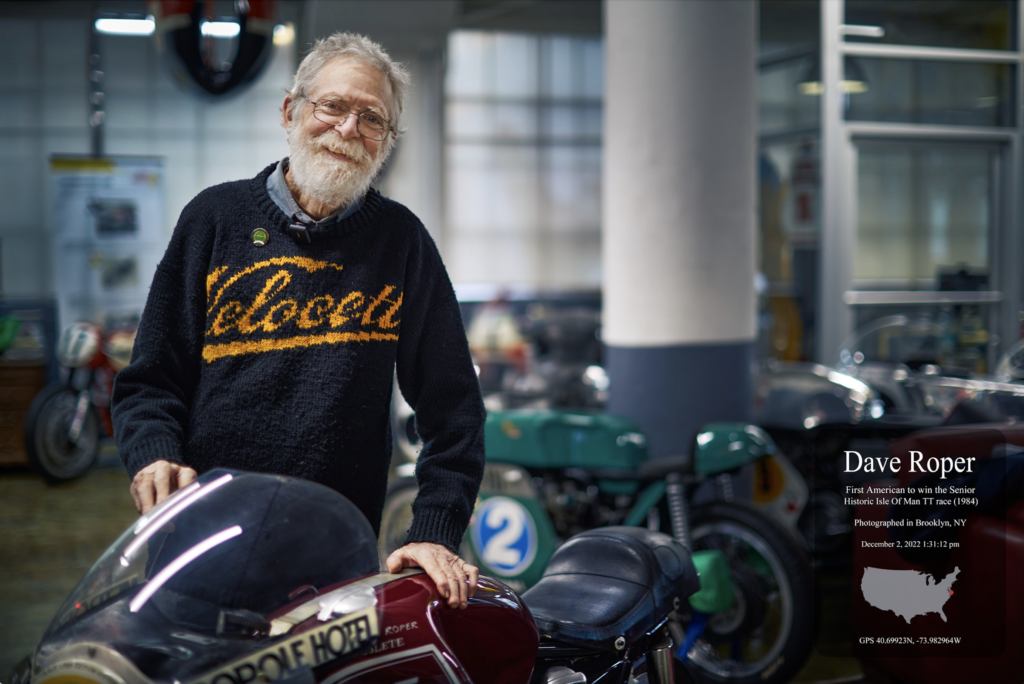
Who is Dave Roper?
I'm Dave Roper and I've been obsessed with motorcycles for most of my 74 years. I live in Hicksville, Long Island, New York, spend most of my time playing with motorcycles. As a kid, I was riding bicycles. And that was a gateway of freedom explore. But I was also very much into sports cars, used to go up to Lime Rock Park and watch the sports cars and thought I wanted to do that, be a sports car racer, but some time in high school.
How I got started:
I was introduced to motorcycles. And I totally flipped and became obsessed with motorcycles and lost all interest in the cars. I started racing in 1972. On the club level, did novice professional AMA racing up through the clubs and got involved the team obsolete and started traveling around the world. My biggest win was winning the 1984 Senior Historic TT was the high point of my career. And it's been all downhill ever since.
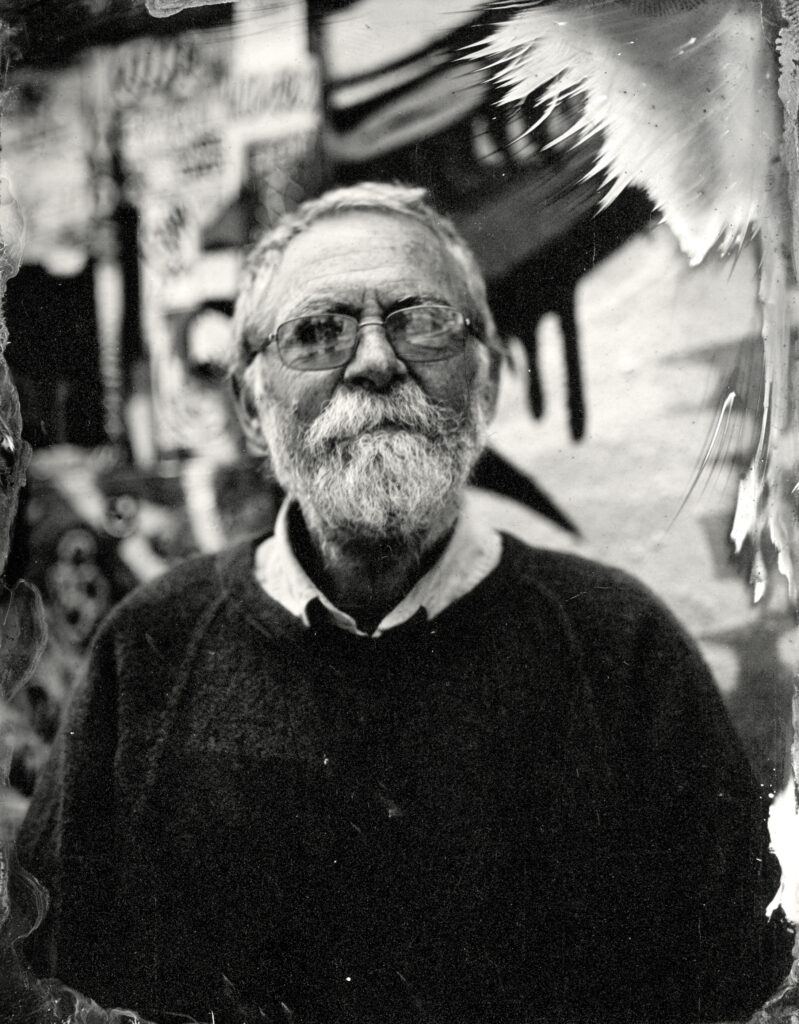
A great story that could only happen with motorcycles:
What’s important to me in racing, it's varies a lot. I've been to a lot of high profile events, where there's a lot of media and riding with famous racers and riding exotic bikes. And it's great fun and very exciting. But there's also something very rewarding about going to an absolutely nothing club race, people are there because they love doing it. And it's very genuine, there's no pretense and so in many ways, I enjoy that every bit as much as being at a Grand Prix or the Isle of Man or whatever.
What do motorcycles mean to you?
Motorcycles are important to me mainly just because the motion, the sensual nature of the scenery wizzing by. In a car, you turn a wheel which turns a shaft which turns a gear which turns a tie rod, and a motorcycle, you just move your body and and the bike responds to your body. And so it's a very direct connection with this image one has in their mind about where they want to go and going there. And so whether I'm riding a bicycle, or riding a motorcycle as long as I'm on two wheels, I'm happy.
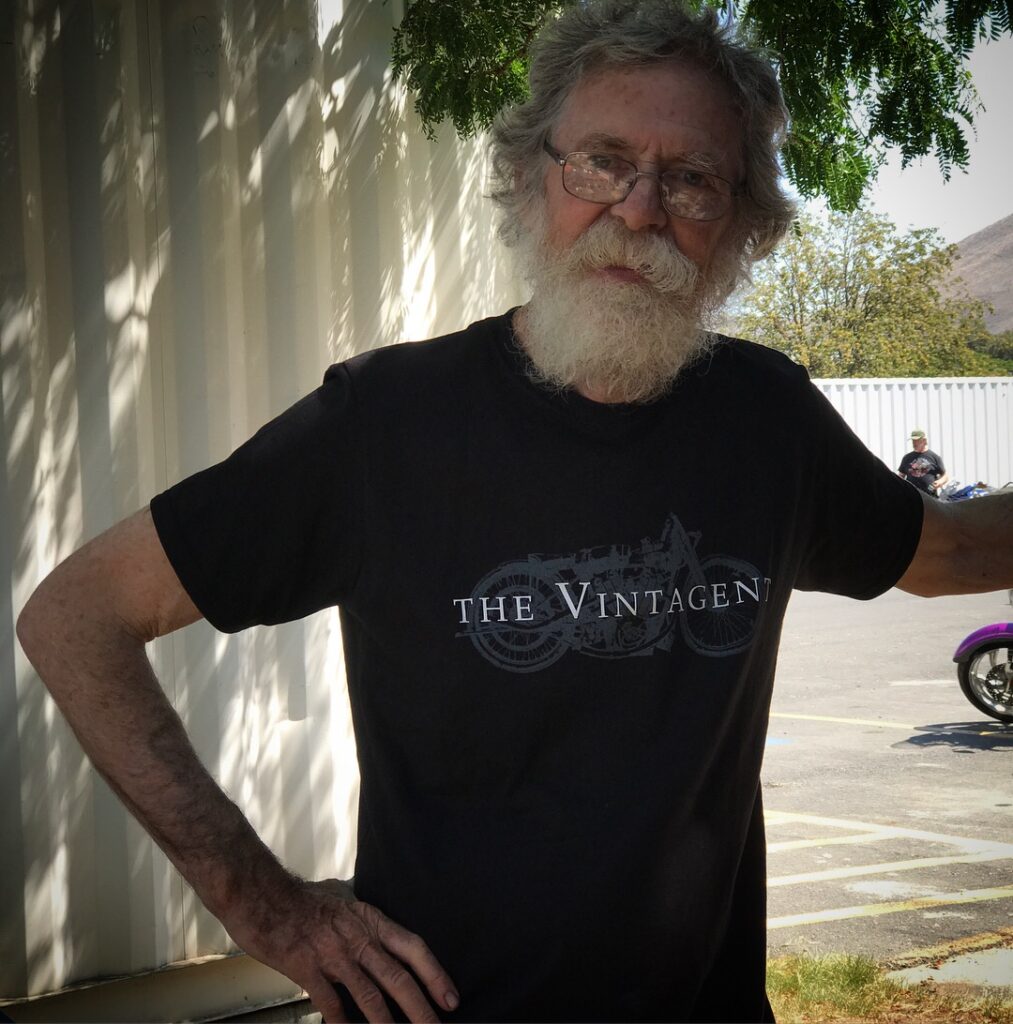
[To see more Motorcycle Portraits, click here]

The Motorcycle Portraits: Sinje Gottwald
The Motorcycle Portraits is a project by photographer/filmmaker David Goldman, who travels the world making documentaries, and takes time out to interview interesting people in the motorcycle scene, wherever he might be. The result is a single exemplary photo, a geolocation of his subject, and a transcribed interview. The audio of his interviews can be found on The Motorcycle Portraits website.
The following Motorcycle Portraits session is with Sinje Gottwald, a motorcycle adventurer who's been mostly on the road for years, on a variety of machines. While she began her RTW trip on a BMW GS, she's currently traveling on a CAKE Kalk through Africa, in an attempt to set a long-distance record with an electric motorcycle. You can follow her amazing Instagram feed here.
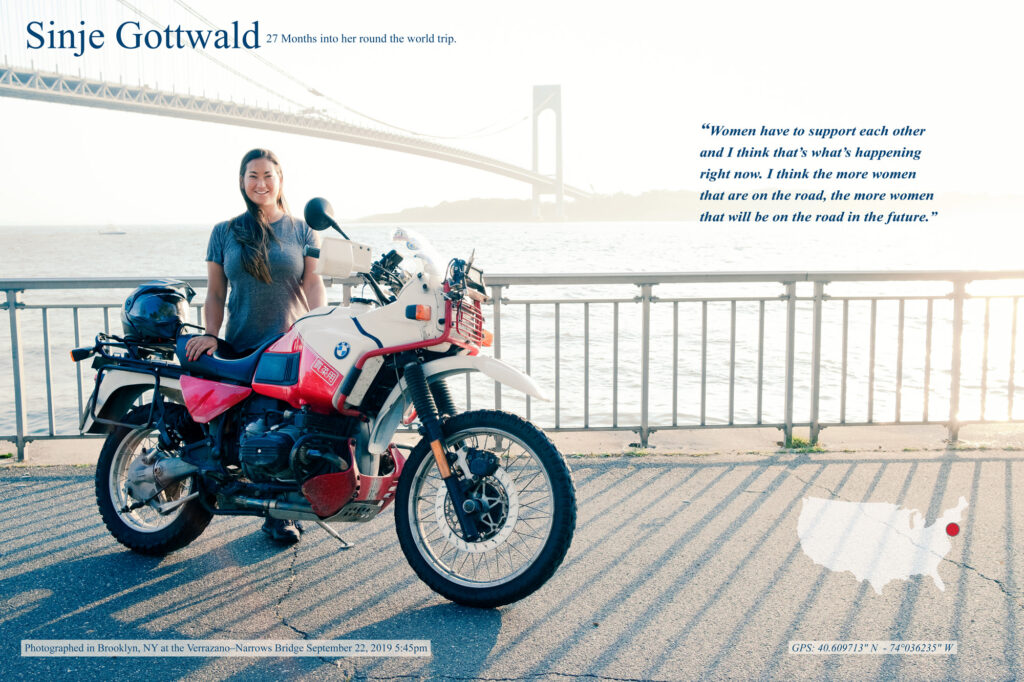
Tell us about yourself:
So My name is Sinje, I come from Stuttgart Germany, and I was born there in 1983. My mom is Korean, my dad is German, and I got into motorcycling cause my dad: he used to travel a lot on motorcycles in the 70’s and so he always told me all of his stories. He rode all the way from New York to Ecuador he also rode from German to the Ivory Coast and all those stories that he always used to tell me and my siblings were always so interesting to me so that’s when I first got into motorcycling. I used to ride on the back of his motorcycle since I was about 5 years old.
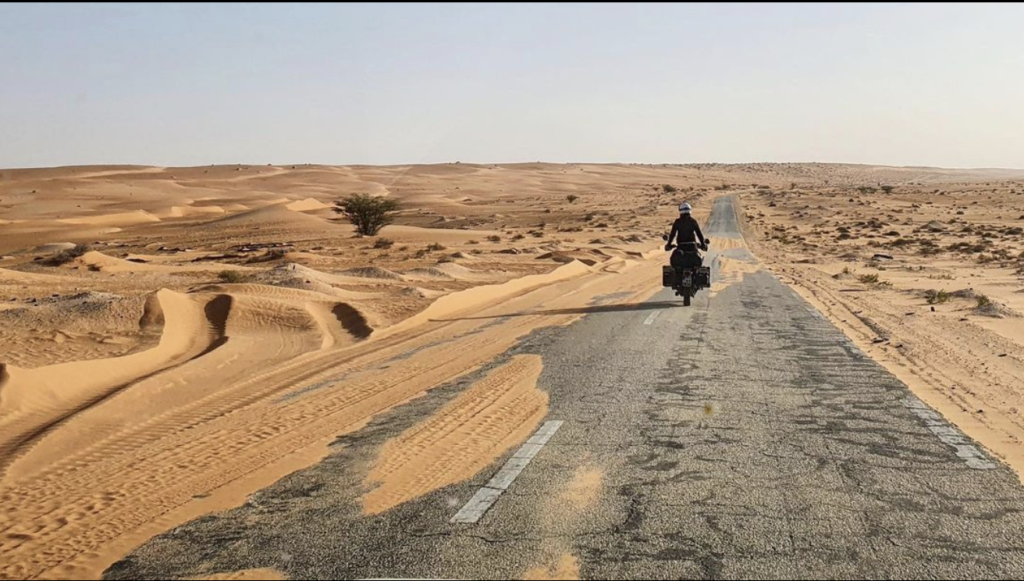
How did you first get interested in motorcycles:
I first got into motorcycles because of my dad. He used to travel a lot and I thought it was really cool what he did. When I turned 24 I got my license and went on my first big trip to Morocco. When I first got my license 10 years ago, I just wanted to ride a motorcycle - that was basically it. I just wanted to ride. I had different pictures in my head of course. You know, freedom and being able to get from one place to another. I’ve been traveling around the world on a motorcycle for 27 months now, and after being on the motorcycle for such a long time, the way l look at it and the way I feel about riding motorcycles has changed completely. I often get asked if I couldn’t do this whole trip in a car or in some other vehicle. I think riding a motorcycle in places, especially places that are unknown to me, is very different. People always - wherever I stop - walk up to me and are interested. They want to know about the bike, they want to know what model, even people who are not interested in motorcycles generally, they want to know about the bike, they want to know where we’ve been. I think the bike is a magnet somehow. To me it’s more of a door opener, it helps me to get in contact with other people in different places, and I think you wouldn’t have that if you were in a car.
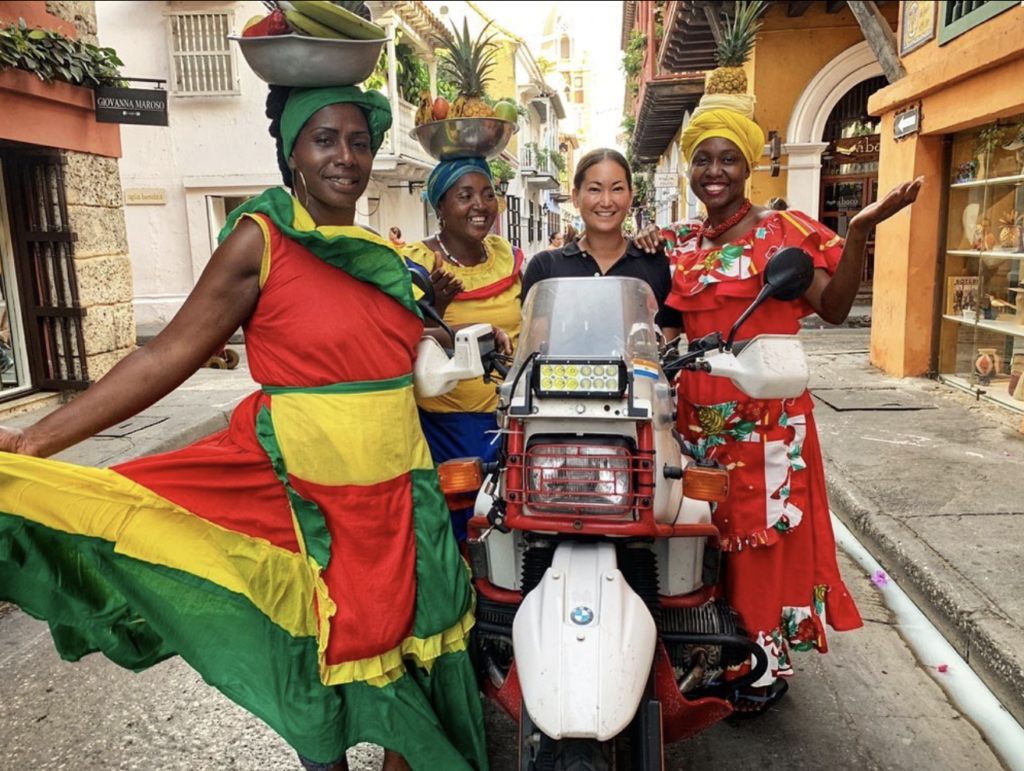
Tell me a story that could not have happened without motorcycles in your life:
When I decided to go on this trip around the world, I only had about 3 months to prepare for the whole trip. And I didn’t have a bike. First I had to decide on and get a bike within a very short period of time. I talked to a couple of people and every person told me to get a different bike, so at one point I just decided to go and take a look at different bikes. When I found this specific bike that I’m riding around the world with now, I knew exactly that it was going to be it. It’s a 1994 Urban GS PD, an old BMW, and I decided to take it, first because I felt very comfortable with it, and second it’s an old bike so it’s very mechanical. I thought it would be easier to get it repaired once I was in countries where there are no mechanics for bigger bikes.
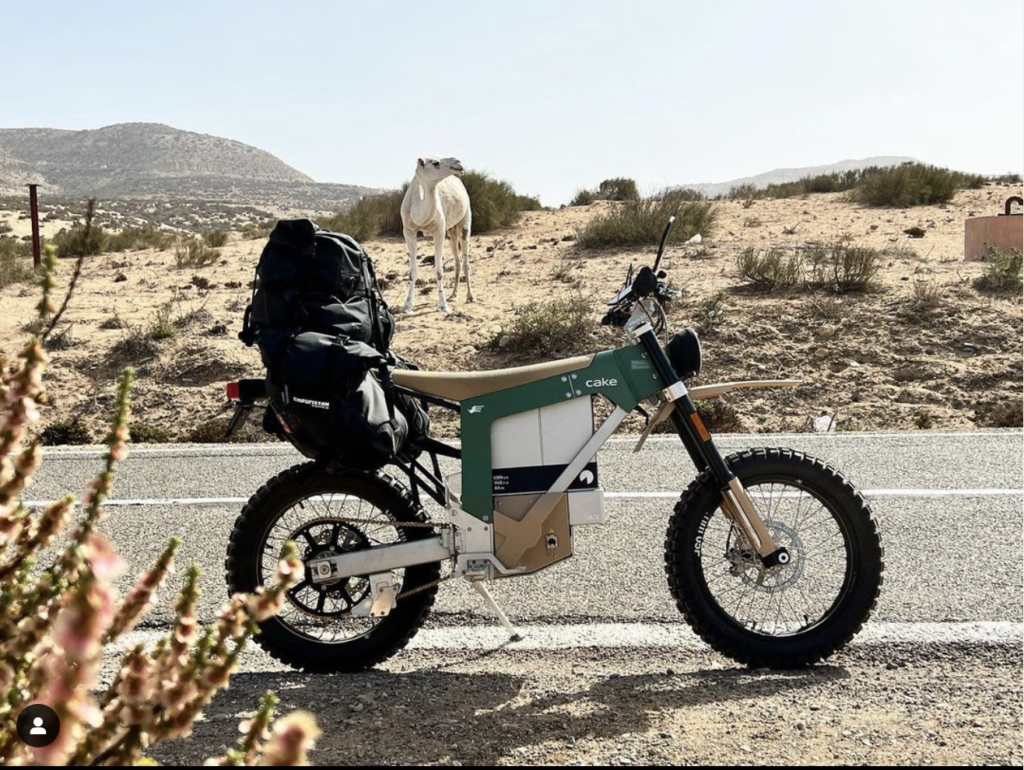
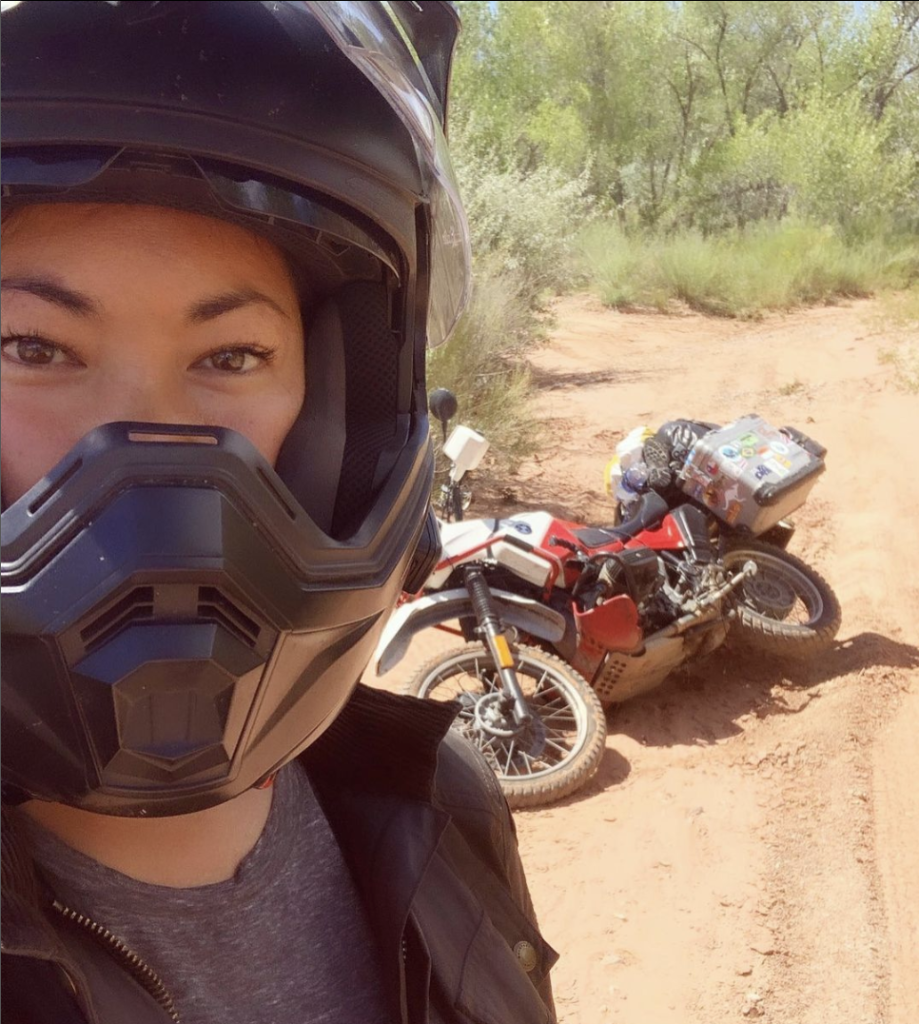
What do motorcycles mean to you:
So riding solo as a woman I didn’t really think about it as being special in the beginning, but now that I’ve been on the road for such a long time, I realize that it’s a bit sad, but it’s still very special in our society, in our world, and I only met three other women who ride solo around the world on this trip in two years. I’ve met so many other people; guys, groups, couples, but female solo riders not so many. Wherever I go most people ask me “so where’s your group. Where is the rest of your group?” When I tell them I’m alone their faces change, everyone is really amazed by it or even surprised, and some people say you're crazy. How can you do it, are you not afraid of being alone on the road as a woman, and sometimes I think it’s really annoying that some people say “as a woman” As a woman it must be so and so difficult or dangerous whatever. But unfortunately as a woman, you have to be a bit more cautious when you’re on the road and yeah, I do whatever I can so that I don’t risk too much. I also learn on the road that riding around the world alone is inspiring to other women. I didn’t realize that at the very beginning, but now I get lots of emails and messages via social channels and I’m happy that some other women now have got inspired and think that because me and some other women that are riding around the world solo that they can do it as well, and I think that’s a good thing. I think we all as women we have to support each other and I think that’s what’s happening right now. I think the more women that are on the road, I think the more women that will be on the road in the future.
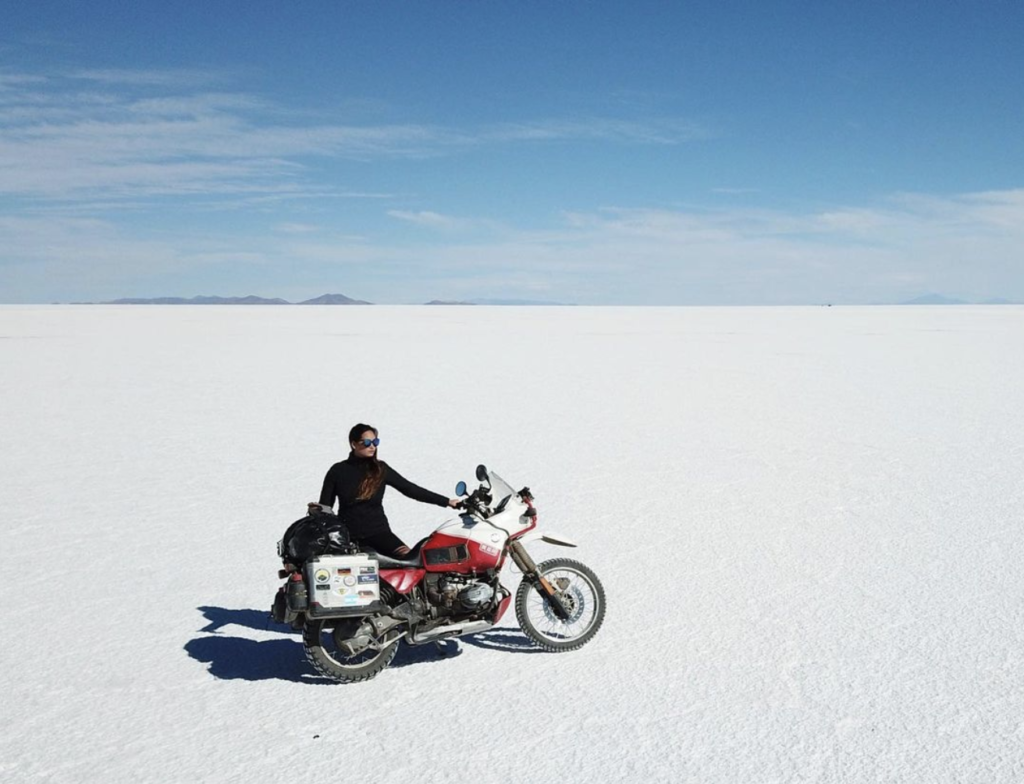

The Motorcycle Portraits: Shinya Kimura
The Motorcycle Portraits is a project by photographer/filmmaker David Goldman, who travels the world making documentaries, and takes time out to interview interesting people in the motorcycle scene, wherever he might be. The result is a single exemplary photo, a geolocation of his subject, and a transcribed interview. The audio of his interviews can be found on The Motorcycle Portraits website.
The following portrait session is with Shinya Kimura, the legendary motorcycle artisan who first came to worldwide attention by inventing the Zero chopper style in Japan. He moved to California in 2006, and set up shop in Azusa as Chabott Engineering, and began exploring new styles of customizing motorcycles, which evidenced a hand-made quality that was at odds with the dominant fat-tire chopper style of the era. Shinya has been featured many times in The Vintagent, and we're always happy to see him in our pages. Here is a transcript of his interview with David Goldman:
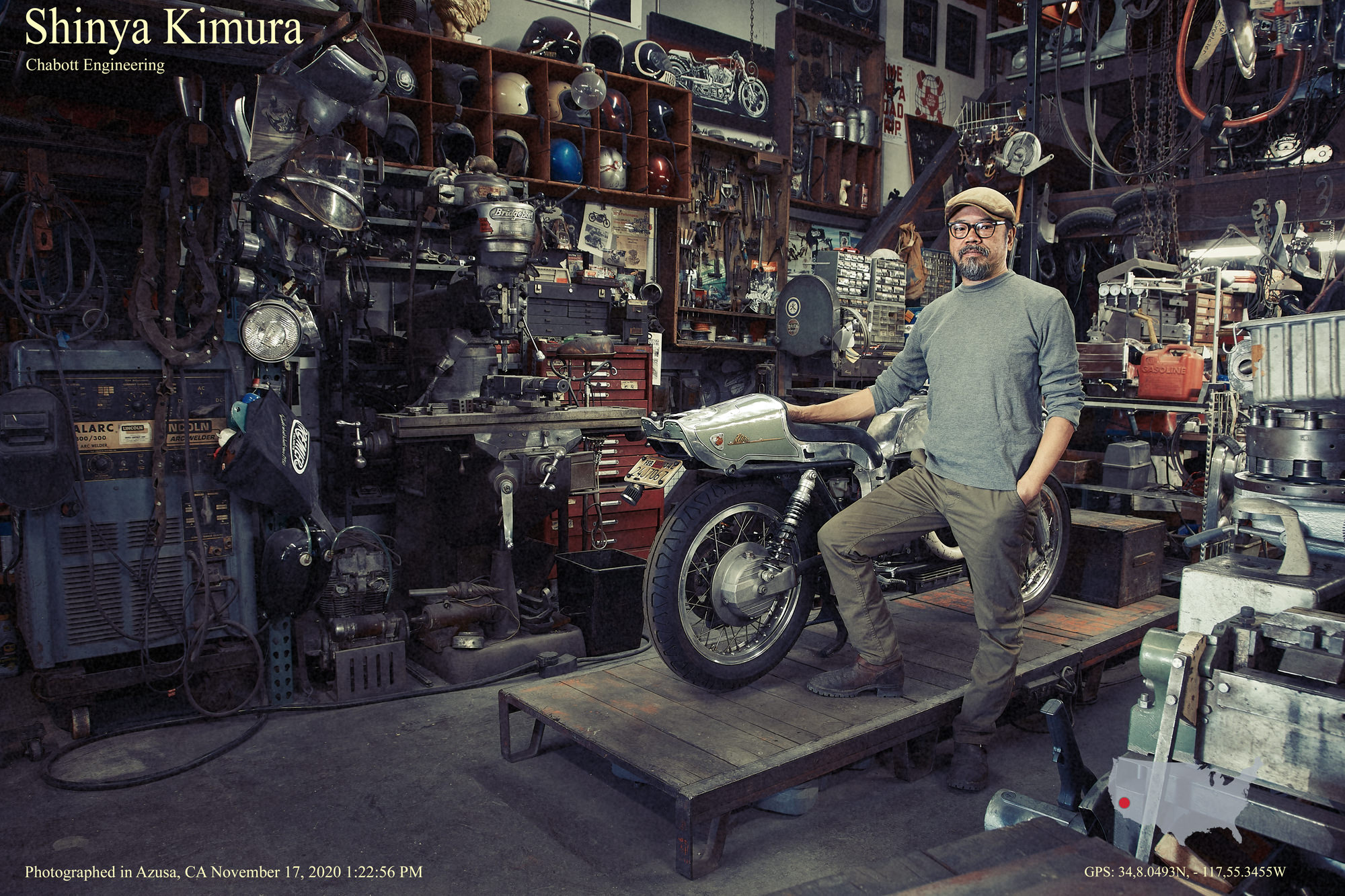
"My name is a Shinya Kimura. I was born in Tokyo in 1962. I moved to California in 2006. And I have a shop in Southern California named Chabott Engineering. Basically, I'm customizing motorcycles, every kind of motorcycle, riding motorcycles, enjoying motorcycles. When I was six years old, my cousin had a small Honda, maybe 90 cc or 50 cc, I don't know. But he took me on his back seat. That is my first experience of a motorcycle and I was excited. When I was a high school student, most of my friends were riding motorcycles So naturally, I started to ride a motorcycle when I was 16 years old, and my first customized motorcycle was a Suzuki 50cc. I made it like a chopper. The most exciting experience for me is the Motorcycle Cannonball. It was a cross-country race from East Coast to West Coast taking classic motorcycle like 1920s or Teens or older. It takes 17 days to make it all the way. At the beginning, I didn't know much about a Teens motorcycle, actually. I took 1915 Indian motorcycle; I got a basket case 1915 Indian but and I fixed it up and made it a rideable motorcycle, but I didn't think I could make it across the country. Actually I got a broken motor maybe several times… I had to fix at midnight to the next morning. Finally I could make it go and I was very excited. Motorcycling is the only thing which I can do like thinking like breathing or having some dinner. Something very natural for me. I always enjoying riding motorcycles."
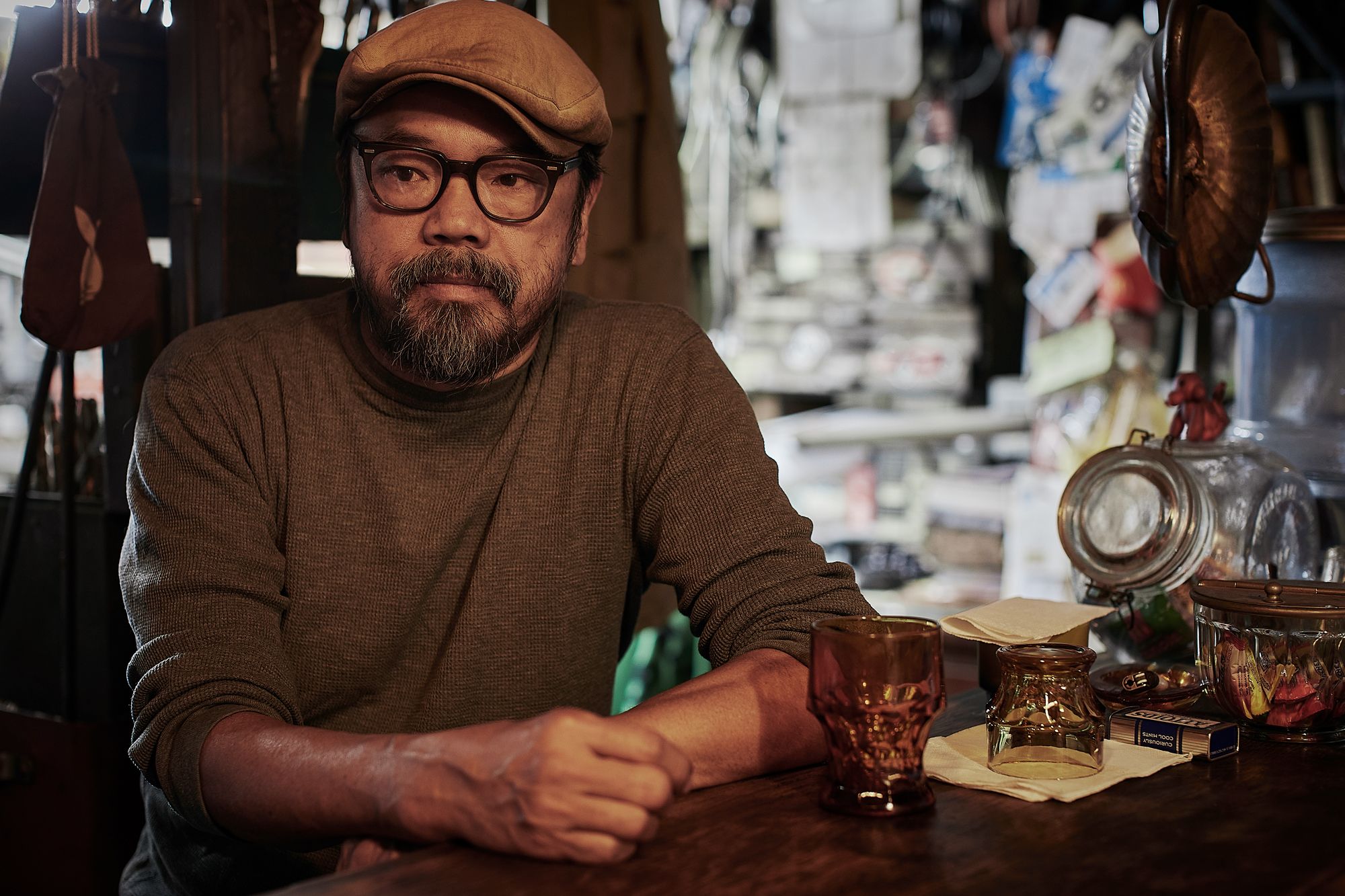

The Motorcycle Portraits: Max Hazan
The Motorcycle Portraits is a project by photographer/filmmaker David Goldman, who travels the world making documentaries, and takes time out to interview interesting people in the motorcycle scene, wherever he might be. The result is a single exemplary photo, a geolocation of his subject, and a transcribed interview. The audio of his interviews can be found on The Motorcycle Portraits website.
The following portrait session is with Maxwell Hazan: motorcycle artist extraordinaire. Max burst on the custom motorcycle scene in 2012, with innovative creations that had an immediately recognizable signature: silver machines with a light, elegant structure, and novel proportions of their components. The Vintagent first encountered Max in Brooklyn in 2012, and the following year he moved to Los Angeles, where his career really blossomed, and he vaulted to the pantheon of globally recognized moto-artists. David Goldman asked Max a few questions about motorcycling: here are his responses.
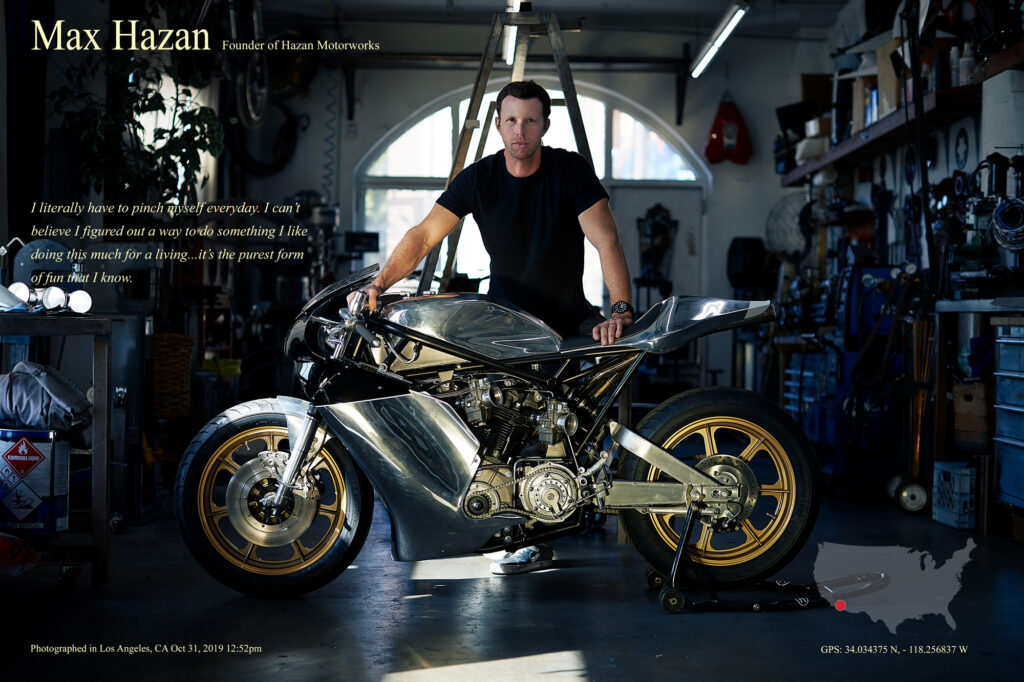
"My name is Max Hazan, I build custom motorcycles here at my shop in Los Angeles. I started building motorcycles about 8 years ago full time. It wasn’t something that I set out to do; I had crashed a bike in an off-road race and couldn’t walk for a while, and was looking to pass the time. I always build stuff, and I motorized a beach cruiser bicycle I had in my apt. I decided to build something after that because it went faster then I thought it was going to go. I was like, 'you know what, we need to use motorcycle parts.' A few years went by and I went back to my job and didn’t think anything of it, but I kept building bikes, and I was selling them. I had lunch with my dad and he said, “I think you got something here.” He gave me the push to go for it full time and said he would help out if I needed it and he would give me a year. It actually didn’t work in that year. I was ready to go back to my job and I was like 'you know what, I tried.' Two days later the phone rang, and someone wanted to commission a bike, and I sold another one after that, and it worked. It was something that I didn’t intend to do, but I’m happy it worked out like that.
It’s the purest form of fun that I know.
So, motorcycles. You know there was not one moment that [they] really hit me. It’s not like 'I saw a chopper one day.' As far back as I could remember I loved motorcycles, I don’t know what it was. These were dirt bikes, there was something I was just drawn to, and I liked it. I grew up riding bikes, but then living in NY and going to college and getting a job, it kind of went away. It wasn’t until years later I was looking at things to do outside of the city, that I got into riding again. Like I mentioned, it’s also how I got hurt. As far as a moment defining when I started liking motorcycles it was literally innate. It was as far back as I could remember.
I get asked the question a lot, “what does motorcycling me to me?” I always thought I needed some kind of profound answer, and I was trying to think of something, but to be honest, it’s fun. It’s the purest form of fun that I know. My brain is always going a million miles an hour, and it’s the one thing that’s actually is calming to me is riding a motorcycle fast. It’s something that forces your attention to be in the moment. So honestly it’s peace of mind. That’s the biggest takeaway from motorcycling. Doesn’t matter if you are on a track or on a Harley going 20 miles an hour, it’s forced participation in the moment and you don’t have to think about anything else
So, I think of the experiences motorcycling has given me and the one biggest effect on me is doing it every day for work. I walk into the shop and I literally have to pinch myself every day, I can’t believe I figured out a way to do something I like this much for a living. You know it’s not the best sales thing to tell your clients “I’d do it for free” but honestly, you know I would. I would do this every day."

The Motorcycle Portraits: Anya Violet Aghababian
The Motorcycle Portraits is a project by photographer/filmmaker David Goldman, who travels the world making documentaries, and takes time out to interview interesting people in the motorcycle scene, wherever he might be. The result is a single exemplary photo, a geolocation of his subject, and a transcribed interview. The audio of his interviews can be found on The Motorcycle Portraits website.
The following portrait session is with Anya Violet Aghababian: rider, event organizer, entrepreneur. Anya co-founded the all-women ride/camp weekend Babes Ride Out, the women's dirtbike gathering Babes in the Dirt, and the women's motorcycle gear company Atwyld. The term badass comes to mind when considering Anya's accomplishments and cultural impact, giving women not only safe places to gather and ride, but also the gear to get there in. Here are some of Anya's thoughts on riding:
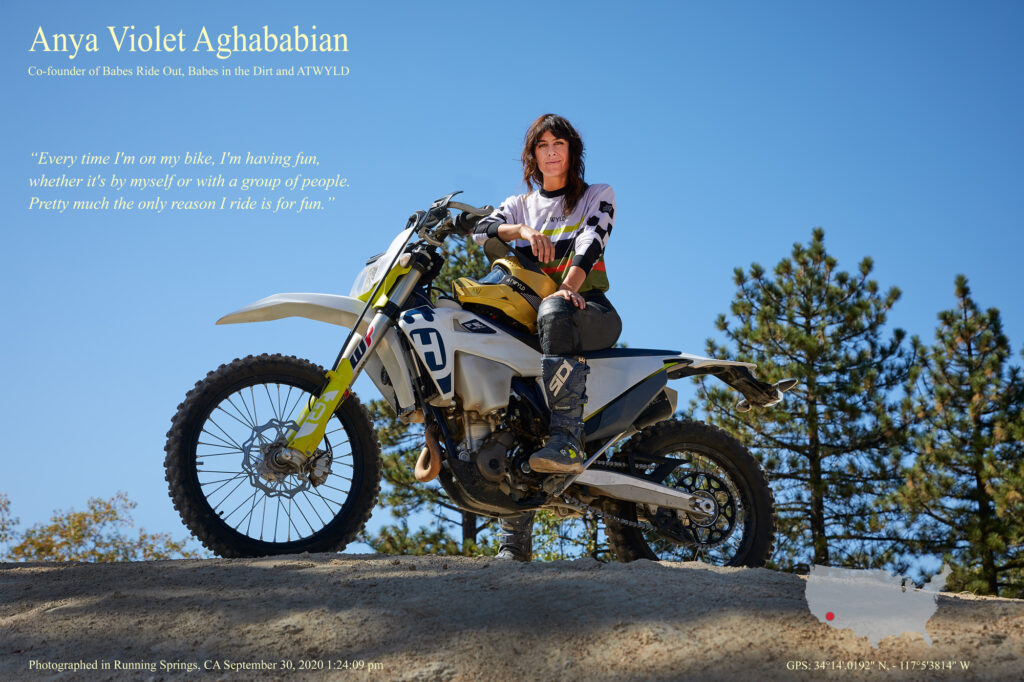
First Experiences
I first got into riding motorcycles when I was about seven years old, running on a 50 cc dirt bike. Both my parents had a background in motorcycling, my dad riding a street bike and my mom on any dirt bike. And yeah, we all used to ride trails and race on the central CA coast where I grew up, and it's something that has trickled over into my adult life.
What Does it Mean?
So what does motorcycling mean to me? Fun, it means fun. Every time I'm on my bike, I'm having fun, whether it's by myself or with a group of people. That's pretty much the only reason I ride is for fun. Today we're in Green Valley Lake at the entrance to some of my favorite off-road trails.
Great Experiences
One of the greatest motorcycle experiences I've ever had was actually this year. Earlier this year, me and seven other girls rode dirt bikes through the Sahara desert for five days, it was an incredible experience through crazy sand dunes and just out in the middle of the desert and dry lake beds. And it was absolutely beautiful. It happened actually right when the whole COVID thing hit: we thought we might get stuck in the desert in Morocco. So we ended up having to cut the the trip a little bit short and banzai back to get out of the country before they closed the borders. So we ended up being the adventure of a lifetime essentially because so many things happened while we were gone basically the world was falling apart. And here we are ripping through the desert on dirt bikes, trying not to care about it. But when things got really serious, we had to turn around and get out of there and we basically got out of the country by the skin of our teeth. The memories of that trip will definitely last a lifetime. One of the greatest moments of that trip was climbing this 400 foot tall sand dune - it was crazy. It was like this sea of sand dunes and you're kind of like surfing them, it really feels almost like surfing a wave: you're kind of cresting and coming back down and then peaks and valleys and there's this one 400 foot tall dune and you just gotta like really power up it, but right when you get to the top you have to let off the throttle a little bit so you just peak right at the very top of the dune and it is the most beautiful overwhelming feeling when you are that high up and all you see is an ocean of sand dunes and it's it's was such a surreal moment - I will never forget that.

The Motorcycle Portraits: Robb Talbott
The Motorcycle Portraits is a project by photographer/filmmaker David Goldman, who travels the world making documentaries, and takes time out to interview interesting people in the motorcycle scene, wherever he might be. The result is a single exemplary photo, a geolocation of his subject, and a transcribed interview. The audio of his interviews can be found on The Motorcycle Portraits website.
The following Motorcycle Portraits session is with Robb Talbott, owner of the Moto Talbott Collection in Carmel Valley, CA. If you've been to the Quail Motorcycle Gathering or the Las Vegas motorcycle auctions, you've seen Robb and some of his amazing collection of motorcycles, and if you're lucky, you've had a chance to talk with him and experience first hand the joy and enthusiasm he brings to the motorcycle scene.
A Great Memory
One of my great memories and greatest stories happened in Colorado Springs, Colorado, in the winter of 1971. I was drinking beer with my buddies at this pizza parlor in Colorado Springs: later on in the week was a pretty momentous motorcycle race. So after three or four beers (or I think maybe more), my good buddies talked me into doing the Snow Run, which was a race up Pikes Peak on January 1. And I thought, wow, I've never done that, and it sounds like a pretty exciting race. So they talked me into it. I prepared to get up at five o'clock that morning, and we drove up Pikes Peak to Glen Ellyn (which is somewhere around 8000 feet): the race started there, and it was 25 degrees out. And I was sitting there freezing, I thought 'this is pretty cold'. But I was in my black leather racing suit, and I was really excited to start as number 220! Then we started, all at once. The adrenaline was pumping. We raced all the way to the top of Pikes Peak, which is 14,110 feet high. I did fairly well out of 225 bikes, I rode to sixth place!
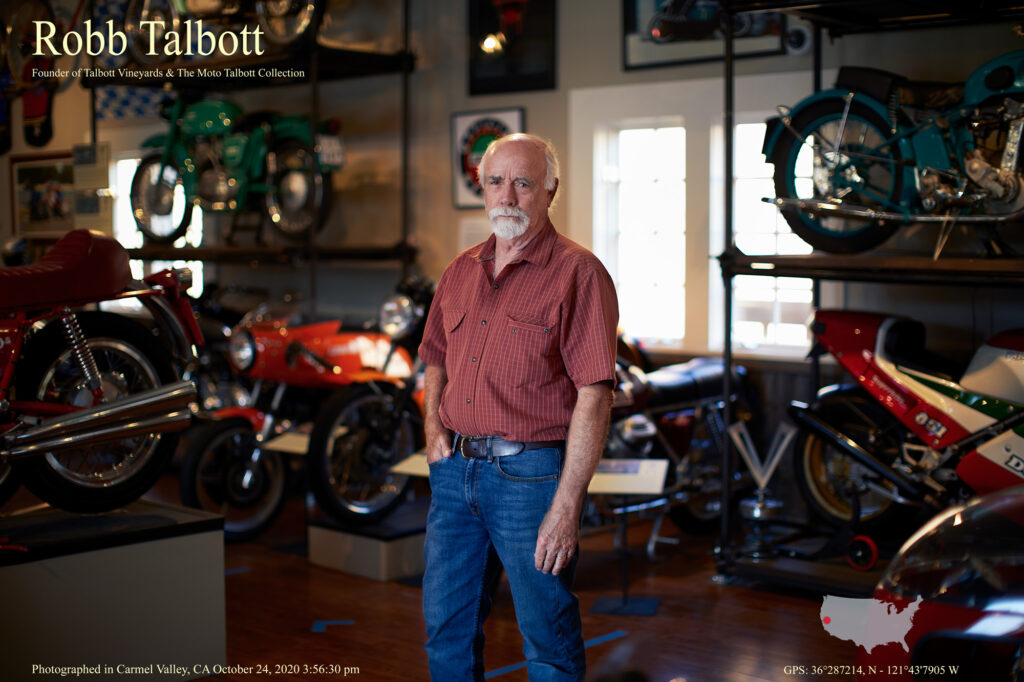
Sitting up on top though, we understood. We understood how cold it was. There was a thermometer on the warming house Warming House door that said it was minus 32 degrees! And the warming house door was locked! All of us sat there at the top of Pikes Peak, on that barren mountain, freezing to death. The race was run on ice and snow, and of course it wasn't paved in those days. Going down was the coldest! It was a lot colder than racing up because I didn't have adrenaline. People were covering themselves with anything they could find, and one poor fella put duct tape on his face to act as a windshield, but when he pulled the duct tape off, his skin pulled off too. We were back at Recife's that night where the whole thing started - drinking beer. I wouldn't have missed that race for anything in the world. It injected me with enough adrenaline to get me into motorcycles and now I'm almost 73 years old. I'm still into going fast on motorcycles. so I'm really glad I ran that race at speed.
Riding keeps me young
To me riding a motorcycle is one of the most complex, thrilling adventures that I can do for myself. It can change how I'm thinking for the day, for the week, for the month. The term 'freedom' is always used, and yes, you're free to a point, but you have to focus so you don't kill yourself. We have cell phone drivers, we have deer, we have animals. We were taught never to hit any animal bigger than what you could eat that night on a plate. Where I live, the fears and worries of hitting deer are incredible. But what does it mean when I get on a bike? I I focus on riding. I focus on the area. I love turns. I love mountains. I just went to Colorado and put almost 4000 miles on my Ducati driving over passes and enjoying the scenery. But that focus is important to keeping young for me: riding keeps you young because you're not in a car surrounded by a heater, or Bluetooth or air conditioning, with rolled up windows. You're smelling roadkill, you're smelling the sage, and when you cross Nevada. you're smelling the fires that have run through. For example, up in Wyoming there were 17 fires in the summer of 2012 that I rode through: you are involved with the world that you're riding through, you're involved with nature, you're involved with temperatures, from the animals to the sun, it evokes danger, it helps your adrenaline stay up. It's exciting for me going fast on a bike out in the West, that's my favorite place to ride. It wouldn't be the same on the 95 going to Boston from Florida, which I've done. Riding keeps me young, and I look forward to it, and when I get off that bike, hopefully I'm sore and a little bit cold. I've had a good ride. My day has been made. And then I started planning my next ride. I don't know how I could live without riding, it's definitely in my blood. It's certainly part of my character, and I meet the best people on bikes too. All of us seem to have a common ground. That is amazing. So stay young, stay safe, and ride a bike. I love them. That’s so cool.

The Motorcycle Portraits: Megs Braap
The Motorcycle Portraits is a project by photographer/filmmaker David Goldman, who travels the world making documentaries, and takes time out to interview interesting people in the motorcycle scene, wherever he might be. The result is a single exemplary photo, a geolocation of his subject, and a transcribed interview. The audio of his interviews can be found on The Motorcycle Portraits website.
The following Motorcycle Portraits session is with Megan Griffiths, better known on Instagram as @megs_braap, a dedicated dirt bike and trials rider.
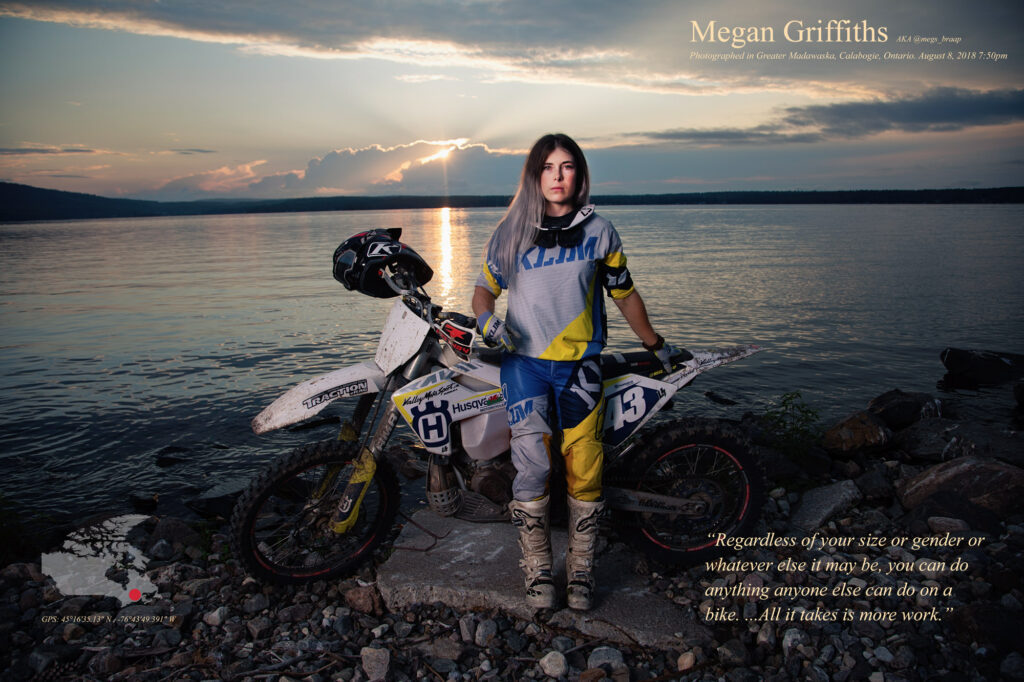
"My name is Megan Griffiths, also known as @mags_braap. I got into dirt biking when I was 17 years old. Ever since I was a kid, I wanted something with a motor, something that could take me places, and eventually, I had enough money to get one. I was choosing between a quad and a dirt bike, so I walked into a Yamaha dealership, and saw a beautiful TTR 125. And thank God, I chose that over the quad.
"Regardless of your size, or your gender, or whatever it may be, you can do anything anyone else can on a bike. I mean, people tend to shy away from riding certain bikes or riding difficult terrain because 'oh, I'm a woman,' or because 'I'm small and I can't touch the ground.' All it takes is more work. It's just more work putting in the time, and you can do anything.
David Goldman (DG): How old were you when you bought your first bike?
Megan Griffiths (Megs): 16 or 17? I can't remember.
DG: And where you grew up, is it common that 16 year olds are buying these kinds of vehicles?
Megs: I think most people start when they're younger, and their parents get them into it.
DG: When you bought your bike did the salesperson think twice about you being a woman?
Megs: They didn't seem to think anything of it. I mean, it was a complete beginner's bike. I'm a small person, and a TTR 125 is a really small bike. So they actually pushed me in that direction. It was a good beginner bike for me.
DG: And where you grew up were there tracks to ride on?
Megs: Yep, but I didn't know about them. At the time, I didn't even know we had such a beautiful trail system. I would just explore fire roads, logging roads, stuff like that. And then eventually I discovered single track. That's where everything started to take off. I didn't have any friends that I rode with. My brother and I actually took turns on the bike: we'd go out together and one of us would like stand in the parking lot while the other went out. And then we'd switch.
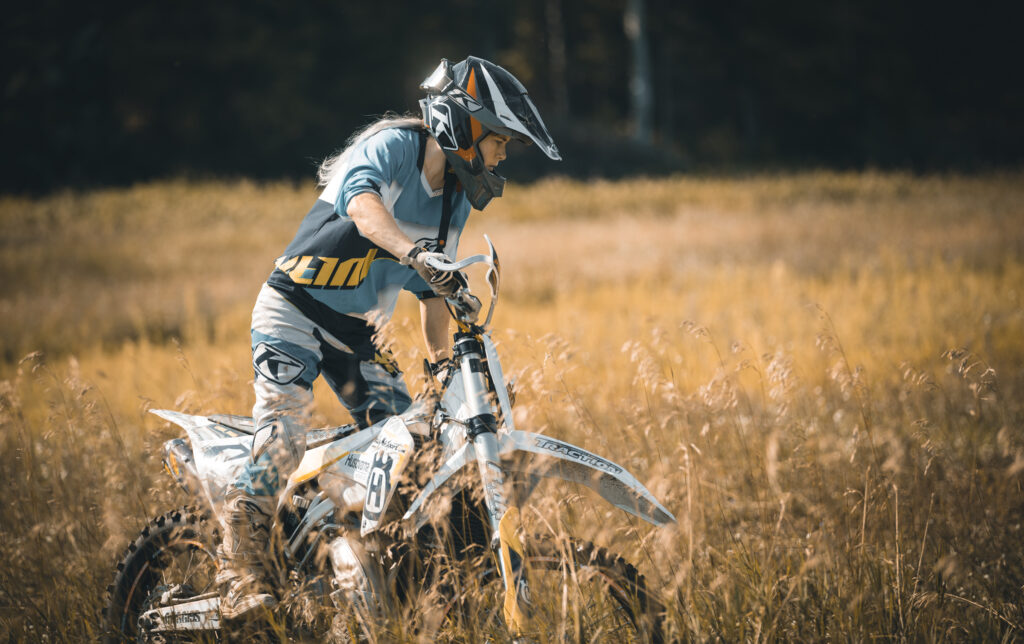
DG: You're pretty big on social media. You have like 130,000 followers. How would you say that happened?
Megs: The right people shared my posts. I mean, I started doing some pretty gnarly stuff. When it actually started was when I posted a video of a three foot suspended log crossing. And I guess most people don't picture a five foot three woman riding over stuff like that. That got shared a lot, and people started seeing my stuff, and it started growing from there.
DG: Did you have other young women reaching out to you, saying that you inspire them?
Megs: Yeah, it happens all the time. And it's actually really empowering, to know that I'm having an influence on other women and men. I mean, that means a lot.
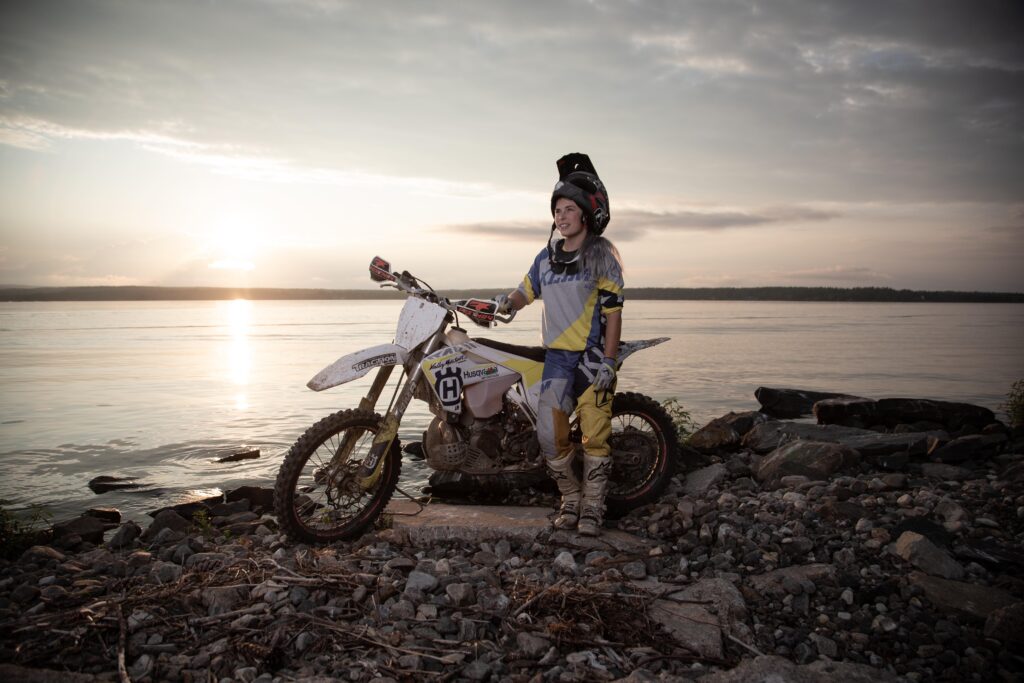

The Motorcycle Portraits: Bobbee Singh
The Motorcycle Portraits is a project by photographer/filmmaker David Goldman, who travels the world making documentaries, and takes time out to interview interesting people in the motorcycle scene, wherever he might be. The result is a single exemplary photo, a geolocation of his subject, and a transcribed interview. The audio of his interviews can be found on The Motorcycle Portraits website.
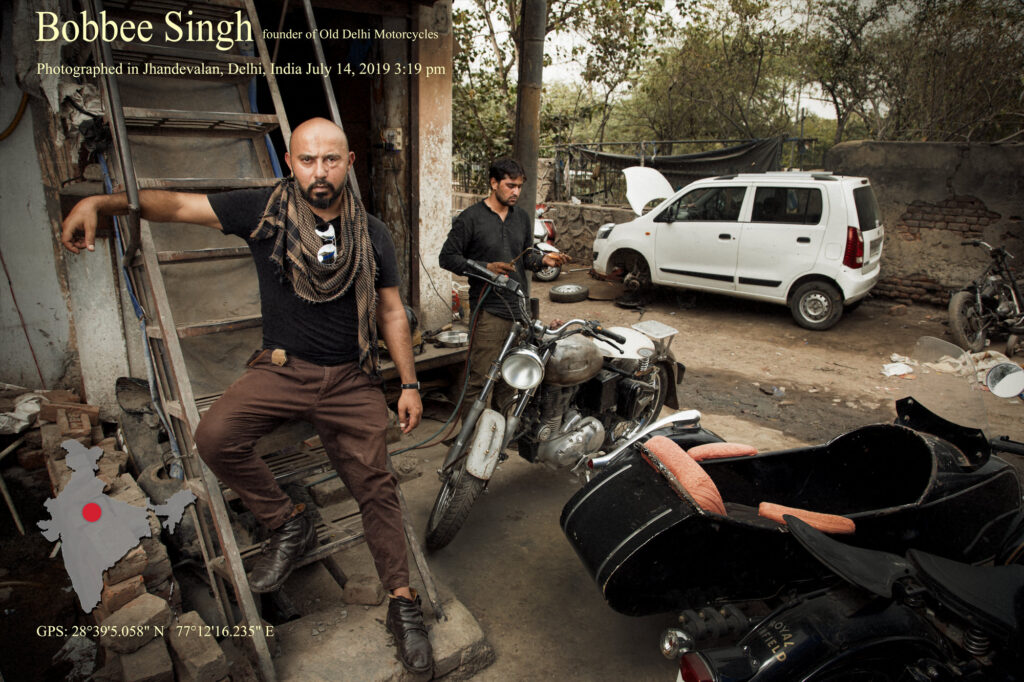
"My name is Bobbee Singh. I make motorcycles in India. I have a company called Old Delhi motorcycles, building mostly vintage Royal Enfields. I’m a so-small lad, and I’m a school drop-out, so pretty much all my life till now - I’m 46 years old - I’ve been building bikes. It’s for this particular feeling: when I was an eleven-year-old boy on my birthday, my parents (my father especially) insisted that I go to the toilet! And I walked in and I put the lights on from the outside and there it was - a faded blue secondhand motorcycle. It’s for that feeling primarily that I build motorcycles. I love bringing a little surprise and a little personal and I love telling a story in a motorcycle. That’s how the disease started in me.
Then I had a neighbor who used to park his motorcycle inside his only room, and put on a big yellow lightbulb and clean it in the night. And I would just sit around him and put grease on my face and on my fingers and just be part of it. I think that’s how it pretty much started. I just fell in love with them.
Ever since the beginning when I got on a motorcycle, I have never really been able to look at it as a scientific phenomenon. You know, it's kind of a magical thing for me till this date, it gives me a mindfuck to see that you sit on something and you kick it, and a sound comes and you do something with your left foot, and you release your right hand. And this thing can take you from here to Himalayas. And it's your balance that rides it. So it's unlike any other experience, you know, that's the spiritual side of it, the spiritual inspiration.
It’s the only time I get to move and think and create and sing and be myself.
All that I am gets complimented by the concept of motorcycles, especially old motorcycles, because I have a mind which lives in the past. I love the old school lines, values, aesthetics, music, style, especially motorcycles. So it's given me not just... I'm not just a professional, it's given me a purpose. You know, I wake up for it every day. All that I am able to put into a motorcycle, it's everything, man - the style, the movement. I think I would die if there were no motorcycles in my life. It's the only time I get to move and think and create and sing and be myself as the ultimate way of rejoicing my life. Building them is another story, you know, thank God that I can build motorcycles for people. And I build them really well: I get into it, piece by piece, hand carved.
So I get these vintage, old motorcycles from villages in the interiors of India, and they are dug in the ground and the owners never want to sell because they love it. So I somehow get there through a clandestine network of informers that's very KGB, and we reach there and have to deal with their fucking egos and tell them 'don't bury the bike man! Let me have the bike, sell it to me and let me make it.' And I get such bikes and I completely open them up and restore them, cycle parts and engine and design on them, and make a unique motorcycle. These bikes get to Stockholm and Paris and you name it - New York, London. And on random days I get these messages of videos of people just standing around these bikes and the owner taking a video from the side and loving it you know, that's that's a big reward for me to see. People really enjoying and loving this motorcycle."
[Editor: The Vintagent crew first met Bobbee in a film submitted to the very first Motorcycle Film Festival in NYC in 2013. He was the subject of a film about his motorcycle shop in Delhi: 'Old Delhi Motorcycles', which you can watch below.]


